KSEEB Class 10 SSLC Biology Chapter 1 Life Processes Notes
Something which is ‘living’ (not dead) is said to be ‘alive’. In most simple terms, ‘alive’ means ‘having life’.
Alive is called ‘jeevit’ or ‘zinda’ in Hindi. We are alive and you are also alive. Those things which are alive are called ‘living things’. All the plants and animals (including human beings) are alive or living things.
Now, an important question arises : What criteria do we use to decide whether something is alive? This is discussed below.
“KSEEB Class 10 Biology Life Processes notes”
The most important criterion to decide whether something is alive (or not) is the movement. Movementis one of the most important signs of life in an organism. All the living things (which are alive) move by themselves without any external help.
In some cases the movements of living things are quite fast which can be easily observed by us but in other cases the movements are very slow and hence observed with difficulty. For example, the movements in most of the animals are fast and can be observed easily but

the movements in plants are usually slow and observed with difficulty. Animals and plants move in different ways. This will become clear from the following discussion.
Animals can move from one place to another or they can move their body parts. For example, a frog moves when it jumps into a pond, a bird moves when it flies in the sky, an athlete moves when he runs and a fish moves when it swims in water.
We move our hands when we clap and our chest moves up and down when we breathe. And a dog can wag its tail. All these movements show that a frog, bird, fish, dog and human beings are alive (or living things).
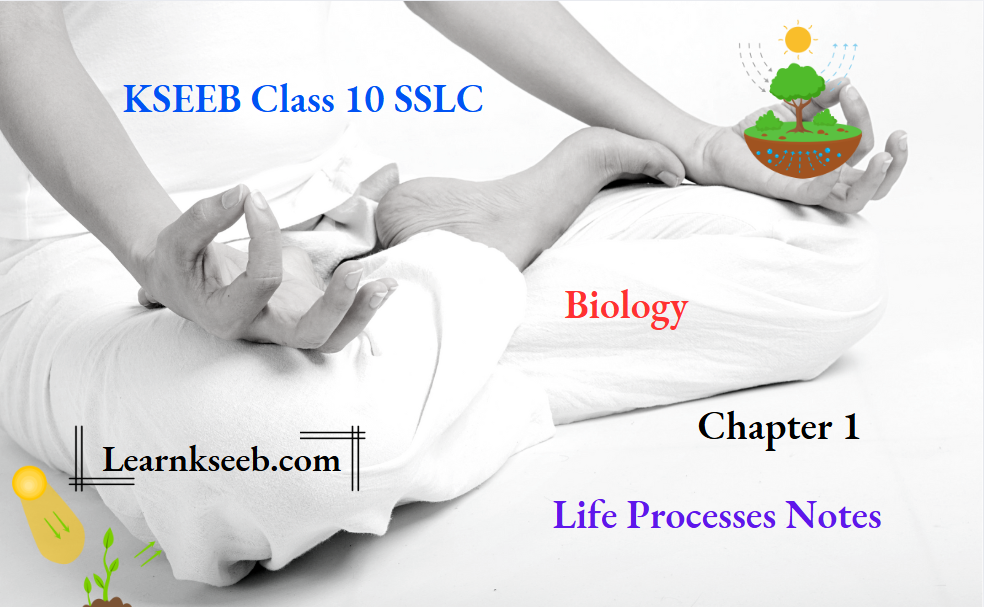
The plants are fixed in the soil at a place, so they cannot move like animals from place to place. The plants can only move parts of their body such as leaves, flowers, shoots and roots. The plant parts move towards a stimulus such as sunlight, gravity or water, etc.
For example, the shoot, the leaves and flower of a sunflower plant move by bending towards the sun so as to face the sunlight.
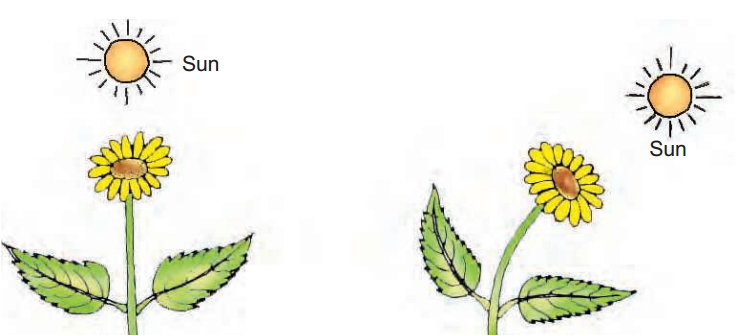
The leaves of a Mimosa pudica plant (sensitive plant) move by folding up when touched with a finger. Plants also show movement by growing their roots and shoots bigger.
Non-living things (which are not alive) cannot move by themselves. For example, a stone is a non-living thing which cannot move by itself from one place to another or show any other type of movement. We will have to move it by applying force from outside.
All the living things (plants and animals) are made up of tiny living units called cells. The cells themselves are made up of still smaller particles called molecules. The movements over very small scale (as those in the molecules of living things) are invisible to the naked eye.
The invisible molecular movement is, however, necessary for the existence of life. In fact, viruses do not show any molecular movement in them (until they infect some cell) and this has created controversy about whether they are truly alive or not. In addition to movement, the living things also show some other characteristics.
These are discussed below.
All the living things (which are alive) have some common characteristics (or features) which make them different from non-living things. The characteristics of living things are as follows:
- Living things can move by themselves.
- Living things need food, air and water.
- Living things can grow.
- Living things respire (release energy from food).
- Living things excrete (get rid of waste materials from their body).
- Living things can reproduce. They can have young ones.
KSEEB Class 10 SSLC Biology What Are Life Processes
All the organisms perform some basic functions to keep themselves alive. The basic functions performed by living organisms to maintain their life on this earth are called life processes.
The basic life processes common to all the living organisms are: Nutrition and Respiration; Transport and Excretion; Control and Coordination (Response to stimuli); Growth; Movement and Reproduction.
- The process of nutrition involves the taking of food inside the body and converting it into smaller molecules which can be absorbed by the body.
- Respiration is the process which releases energy from the food absorbed by the body. Transport is the process in which a substance absorbed or made in one part of the body is moved to other parts of the body.
- Excretion is the process in which the waste materials produced in the cells of the body are removed from the body.
- Control and coordination (or response to stimuli) is a process which helps the living organisms to survive in the changing environment around them.
- The process of growth involves the change from a small organism to a big organism (or an adult organism). In movement, the organism either moves from one place to another or moves its body parts while remaining at the same place.
- The process of reproduction involves the making of more organisms from the existing ones, so that organisms could live on this earth for ever.
KSEEB Class 10 SSLC Biology Energy is Needed for the Life Processes
- All the living organisms need energy to perform various life processes. They get this energy from food.
- Food is a kind of fuel which provides energy to all the living organisms. The living organisms use the chemical energy for carrying out various life processes. They get this chemical energy from food through chemical reactions.
- Actually, living organisms continuously need energy for their various life processes and other activities which they perform. For example, energy is required by an organism even during sleep. This is because when we are asleep, a number of biological processes keep on occurring in the body which require energy.
- Our heart beats non-stop even when we are asleep to pump blood throughout the body. And this beating of heart requires energy. Thus, the working of heart requires a continuous supply of energy.
“SSLC Biology Chapter 1 Life Processes explained”
- The energy required by an organism comes from the food that the organism eats. Thus, food is the basic requirement of all the living organisms for obtaining energy.
- In this chapter we will first study the process of intake and utilisation of the food by an organism (called nutrition) and the liberation of energy from the food (called respiration).
- After that we will study the process of moving the digested food and other materials to the various parts of the body (called transport) and the removal of waste materials from the body (called excretion). Let us start with nutrition.
KSEEB Class 10 SSLC Biology Nutrition
Food is an organic substance. The simplest food is glucose. It is also called simple sugar. A more complex food is starch. Starch is made from glucose. The general name of substances like glucose (sugar) and starch is ‘carbohydrates’.

- Carbohydrates are the most common foods for getting energy. Fats and proteins are also foods. (A wider definition of food, however, also includes mineral salts, vitamins and water which are essential for the normal growth and development of an organism).
- The process of taking in food (consuming food) and utilising it is called nutrition. It is a process in which food is obtained in order to utilise it to provide energy for performing various metabolic activities of the organism.
- Actually, the term ‘nutrition’ comes from the word ‘nutrient’. A nutrient is an organic or inorganic substance required for the maintenance of life and survival of a living organism. In most simple terms, a nutrient can be said to be a particular type of food.
- A nutrient can be defined as a substance which an organism obtains from its surroundings and uses it as a source of energy or for the biosynthesis of its body constituents (like tissues and organs).
- For example, carbohydrates and fats are the nutrients which are used by an organism mainly as a source of energy whereas proteins and mineral salts are nutrients used by an organism for the biosynthesis of its body constituents like skin, blood, etc.
- The food taken in by an organism contains a large number of nutrients like carbohydrates, fats, proteins, minerals, vitamins and water, etc.
- We can now say that: Nutrition is a process of intake of nutrients (like carbohydrates, fats, proteins, minerals, vitamins and water) by an organism as well as the utilisation of these nutrients by the organism.
- We will now describe the various ways of procuring food (or obtaining food) by the different organisms. In other words, we will now describe the different modes of nutrition of the various organisms.
KSEEB Class 10 SSLC Biology Modes Of Nutrition
Modes of nutrition means methods of procuring food or obtaining food by an organism. All the organisms do not obtain their food in the same way. Different organisms have different methods of procuring food or obtaining food. In other words, organisms differ in their modes of nutrition. Depending on the mode (or method) of obtaining food, all the organisms can be classified into two groups: autotrophic and heterotrophic. Thus: There are mainly two modes of nutrition :
- Autotrophic, and
- Heterotrophic.
We will now discuss the autotrophic mode of nutrition and the heterotrophic mode of nutrition in detail, one by one.
KSEEB Class 10 SSLC Biology Autotrophic Mode Of Nutrition
The word ‘auto’ means ‘self’ and ‘trophe’ means ‘nutrition’. Thus, autotrophic means ‘self nutrition’. In autotrophic nutrition, the organism makes (or synthesizes) its own food from the inorganic raw materials like carbon dioxide and water present in the surroundings by using the sunlight energy. We can now say that : Autotrophic nutrition is that mode of nutrition in which an organism makes (or synthesizes) its own food from the simple inorganic materials like carbon dioxide and water present in the surroundings (with the help of sunlight energy). Please note that food is an organic material (like glucose, etc.).
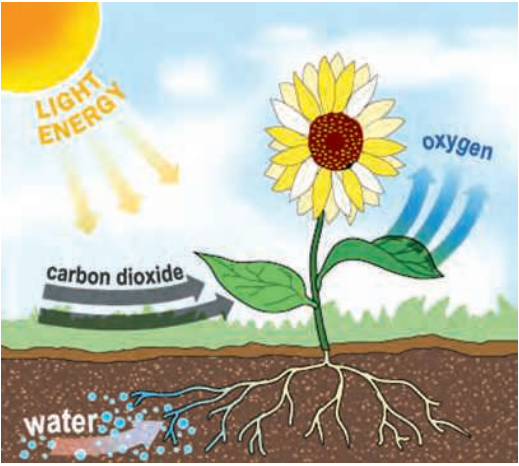
- This means that, in autotrophic nutrition, organic material (food) is made (or synthesized) from inorganic materials like carbon dioxide and water by utilizing the sunlight energy.
- The green plants have an autotrophic mode of nutrition. The autotrophic bacteria also obtain their food by the autotrophic mode of nutrition (though most bacteria are not autotrophic).
- The organisms having autotrophic mode of nutrition are called autotrophic organisms or just autotrophs.
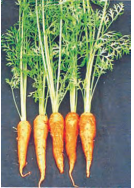 Those organisms which can make their own food from carbon dioxide and water are called autotrophs. Carbon dioxide and water are inorganic substances. So, we can also say that: Those organisms which can make their own food from the inorganic substances present in the environment, are called autotrophs.
Those organisms which can make their own food from carbon dioxide and water are called autotrophs. Carbon dioxide and water are inorganic substances. So, we can also say that: Those organisms which can make their own food from the inorganic substances present in the environment, are called autotrophs.- All the green plants are autotrophs (because they can make their own food from inorganic substances like carbon dioxide and water present in the environment). Non-green plants are, however, not autotrophs. Certain bacteria called ‘autotrophic bacteria’ are also autotrophs.
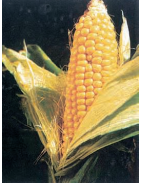
- The autotrophic organisms (or autotrophs) contain the green pigment called chlorophyll which is capable of trapping sunlight energy. This trapped sunlight energy is utilised by the autotrophs to make food by combining inorganic materials like carbon dioxide and water present in the environment by the process of photosynthesis.
- Thus, autotrophs make their own food by photosynthesis. So, autotrophs are the producers of food. The food produced by autotrophs (green plants) is also used by human beings and many, many other animals.
KSEEB Class 10 SSLC Biology Heterotrophic Mode of Nutrition
The word ‘heteros’ means ‘others’ and ‘trophe’ refers to ‘nutrition’. Thus, ‘heterotrophic’ means ‘nutrition obtained from others’. In heterotrophic nutrition, the organism cannot make (or synthesize) its own food from the inorganic raw materials like carbon dioxide and water, and uses the food made by autotrophic organisms directly or indirectly.

We can now say that:
- Heterotrophic nutrition is that mode of nutrition in which an organism cannot make (or synthesize) its own food from simple inorganic materials like carbon dioxide and water, and depends on other organisms for its food.
- A heterotrophic organism is a consumer which derives its nutrition from other organisms. That is, a heterotrophic organism has to eat other organisms for its nutrition.
- All the animals have a heterotrophic mode of nutrition. Most bacteria and fungi also have heterotrophic mode of nutrition.
- The organisms having heterotrophic mode of nutrition are called heterotrophic organisms or just heterotrophs.
- Those organisms which cannot make their own food from inorganic substances like carbon dioxideand water, and depend on other organisms for their food are called heterotrophs.
- All the animals are heterotrophs (because they cannot make food from inorganic substances like carbon dioxide and water and obtain their food from other plants or animals.). Thus, man, dog, cat, deer, tiger, bear, lion, cow, etc., are all heterotrophs.
- The non-green plants (like yeast) are also heterotrophs.
- Heterotrophs depend on autotrophs and other heterotrophs for their food. In other words, animals are heterotrophs which depend on plants or other animals for their food.
- From the above discussion we conclude that green plants make their own food. Non-green plants and animals cannot make their own food. They obtain food from plants and other animals. We will now discuss the various types of the heterotrophic mode of nutrition.
KSEEB Class 10 SSLC Biology Types Of Heterotrophic Nutrition
A heterotrophic organism (or heterotroph) can obtain its food from other organisms in three ways. So, the heterotrophic mode of nutrition is of three types:
- Saprotrophic nutrition,
- Parasitic nutrition, and
- Holozoic nutrition.
We will now discuss the three types of heterotrophic nutrition in detail, one by one. Let us start with the saprotrophic nutrition.
KSEEB Class 10 SSLC Biology Saprotrophic Nutrition (or Saprophytic Nutrition)
Saprotrophic nutrition is that nutrition in which an organism obtains its food from decaying organic matter of dead plants, dead animals and rotten bread, etc.
- ‘Sapro’ means ‘rotten’, so a saprotrophic organism draws its food from rotting wood of dead and decaying trees, rotten leaves, dead animals and household wastes like rotten bread, etc. The organisms having saprotrophic mode of nutrition are called saprophytes.
- We can now say that : Saprophytes are the organisms which obtain their food from dead plants (like rotten leaves), dead and decaying animal bodies, and other decaying organic matter (like rotten bread).

- Fungi (like bread moulds, mushrooms, yeast), and many bacteria are saprophytes. We know that fungi and bacteria are a kind of plants. So, we can also say that saprophytes are the plants which feed on dead and decaying organic matter.
- The saprophytes break down the complex organic molecules present in dead and decaying matter and convert them into simpler substances outside their body. These simpler substances are then absorbed by saprophytes as their food. Please note that saprotrophic nutrition is also known as saprophytic nutrition.
KSEEB Class 10 SSLC Biolog
Parasitic Nutrition
- The parasitic nutrition is that nutrition in which an organism derives its food from the body of another living organism (called its host) without killing it. The organism which obtains the food is called a ‘parasite’, and the organism from whose body food is obtained is called the ‘host’.
- We can now say that: A parasite is an organism (plant or animal) which feeds on another living organism called its host. A parasite receives its food from the host but gives no benefit to the host in return. A parasite usually harms the host. The host may be a plant or an animal.
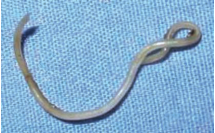
“KSEEB SSLC Life Processes chapter summary”
- Most of the diseases which affect mankind, his domestic animals (like dogs and cattle) and his crops are caused by parasites. Parasitic mode of nutrition is observed in several fungi, bacteria, a few plants like Cuscuta (amarbel) and some animals like Plasmodium and roundworms.
- Thus, the micro-organism ‘Plasmodium’ (which causes malaria disease) is a parasite. Roundworm which causes diseases in man and domestic animals (like dogs and cattle) is also a parasite.
- Roundworms live inside the body of man and his domestic animals. Several fungi and bacteria, and plants like Cuscuta (amarbel) are also parasites. Some other examples of parasites are ticks, lice, leeches and tapeworms.
KSEEB Class 10 SSLC Biology Holozoic Nutrition
‘Holozoic nutrition’ means ‘feeding on solid food’ (which may be a plant product or an animal product). Most of the animals (including human beings) take the solid food into their body by the process of ingestion.
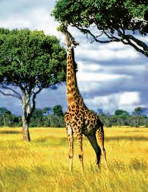
- The ingested food is then digested (broken down) into simpler substances which are then absorbed into the cells of the body. And the undigested and unabsorbed waste materials are egested (thrown out) of the body.
- We can now say that : The holozoic nutrition is that nutrition in which an organism takes the complex organic food materials into its body by the process of ingestion, the ingested food is digested and then absorbed into the body cells of the organism.
- The undigested and unabsorbed part of the food is thrown out of the body of the organism by the process of egestion.
- The human beings and most of the animals have a holozoic mode of nutrition. In other words, man, cat, dog, cattle, deer, tiger, lion, bear, giraffe, frog, fish and Amoeba, etc., have the holozoic mode of nutrition.
KSEEB Class 10 SSLC Biology Nutrition In Plants
- Just like other organisms, plants also require food which can supply energy for their various metabolic activities. Though animals can move from one place to another in search of food, plants just stand still at one place and make their own food.

- Green plants are autotrophic and synthesize their own food by the process of photosynthesis. ‘Photo’ means ‘light’ and ‘synthesis’ means ‘to build’, thus ‘photosynthesis’ means ‘building up by light’.
- The plants use the energy in sunlight to prepare food from carbon dioxide and water in the presence of chlorophyll. Chlorophyll is present in the green coloured bodies called ‘chloroplasts’ inside the plant cells.
- In fact, the leaves of a plant are green because they contain tiny green coloured organelles called chloroplasts (which contain chlorophyll).
- Keeping these points in mind, we can now define the process of photosynthesis as follows: The process by which green plants make their own food (like glucose) from carbon dioxide and water by using sunlight energy in the presence of chlorophyll, is called photosynthesis. Oxygen gas is released during photosynthesis. The process of photosynthesis can be represented as:

- The process of photosynthesis takes place in the green leaves of a plant. In other words, food is made in the green leaves of the plant. The green leaves of a plant make the food by combining carbon dioxide and water in the presence of sunlight and chlorophyll.
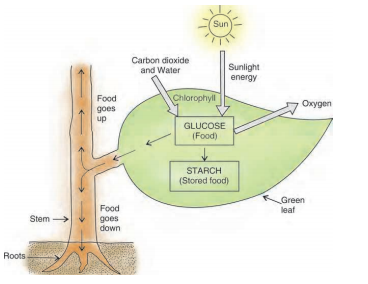
- The carbon dioxide gas required for making food is taken by the plant leaves from the air. This carbon dioxide enters the leaves through tiny pores in them called stomata.Water required for making food is taken from the soil.
- This water is transported to the leaves from the soil through the roots and stem. The sunlight provides energy required to carry out the chemical reactions involved in the preparation of food.
- The green pigment called chlorophyll present in green leaves helps in absorbing energy from sunlight.
- Oxygen gas is produced as a by-product during the preparation of food by photosynthesis. This oxygen gas goes into the air
- The food prepared by the green leaves of a plant is in the form of a simple sugar called glucose. This glucose food made in the leaves is then sent to the different parts of the plant .
- The extra glucose is changed into another food called starch. This starch is stored in the leaves of the plant. Glucose and starch belong to a category of foods called carbohydrates.
- The foods like carbohydrates prepared by photosynthesis contain chemical energy stored in them. Thus, the green plants convert sunlight energy into chemical energy by making
- All these food items have been made by the plants by the process of photosynthesis. carbohydrates (foods). The food prepared by photosynthesis provides all the energy to a plant which it needs to grow.
- And when we eat plant foods (like foodgrains, fruits and vegetables), the chemical energy stored in them is released in our body during respiration.
We will now describe what actually happens during the process of photosynthesis. The photosynthesis takes place in the following three steps:
- Absorption of sunlight energy by chlorophyll.
- Conversion of light energy into chemical energy, and splitting of water into hydrogen and oxygen by light energy.
- Reduction of carbon dioxide by hydrogen to form carbohydrate like glucose by utilising the chemical energy (obtained by the transformation of light energy).
Please note that the three steps involved in photosynthesis need not take place one after the other immediately. They can take place at different times.
“Class 10 Karnataka Board Biology Chapter 1 notes”
- For example, desert plants take up carbon dioxide at night and prepare an intermediate product which is acted upon by the sunlight energy absorbed by chlorophyll when the sun shines during the next day.
KSEEB Class 10 SSLC Biology Conditions Necessary For Photosynthesis.
- It has been found by experiments that the presence of sunlight, chlorophyll, carbon dioxide and water is necessary for the process of photosynthesis. So, we can say that: The conditions necessary for photosynthesis to take place are:
- Sunlight,
- Chlorophyll,
- Carbon dioxide, and
- Water.
- Please note that the conditions necessary for photosynthesis are also the conditions necessary for autotrophic nutrition. We will now describe some experiments to show that sunlight, chlorophyll and carbon dioxide are necessary for photosynthesis by green plants.
- These experiments will also show that leaves finally make ‘starch’ as food by photosynthesis.
- The experiments on photosynthesis depend on the fact that green leaves make starch as food. And that starch gives a blue-black colour with iodine solution.
- Now, ordinarily all the plants have starch in their green leaves, so before we can use a plant in a photosynthesis experiment, the initial starch present in its leaves must be removed.
- In other words, we should destarch the leaves of a plant before using it in a photosynthesis experiment. The green leaves of a plant are destarched by keeping this plant in a completely dark place in a room for at least three days.
- When the plant is kept in a dark place, it cannot make more starch (food) by photosynthesis because there is no sunlight. So, the plant kept in dark place uses the starch already stored in its leaves during respiration.
- The plant will use up all the starch stored in its leaves in about three days’ time. So, after about three days, the plant leaves will not have any starch left in them.
- And we say that the leaves have been destarched. This plant with destarched leaves can now be used in the photosynthesis experiments.
- Please note that we will be using a plant growing in a pot in these experiments. The ‘plant growing in a pot’ is called ‘potted plant’. Let us describe the experiments now
KSEEB Class 10 SSLC Biology Experiment To Show That Sunlight Is Necessary For Photosynthesis
- We take a potted plant having green leaves and place it in a completely dark place for about three days to destarch its leaves. So, in the beginning of the experiment, the leaves do not have any starch in them.
- Take a thin strip of aluminium foil (or black paper) and wrap it in the centre of one leaf on both the sides (while the leaf is still attached to the plant. The aluminium foil should be fixed tightly to the leaf by using paper clips so that sunlight may not enter it from the sides. The aluminium foil should cover only a small part of the leaf so that the remaining part of the leaf remains uncovered and exposed to sunlight. We have covered the centre part of the leaf with aluminium foil so that sunlight may not fall on this covered part of the leaf.
- Keep this potted plant (with partially covered leaf) in bright sunshine for three to four days.
- Pluck the partially covered leaf from the plant and remove its aluminium foil. Immerse this leaf in boiling water for a few minutes. This will break down the cell membranes of leaf cells and make the leaf more permeable to iodine solution (so that it may reach the starch present inside the leaf cells).
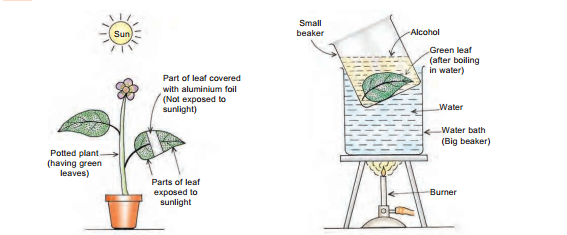

- This leaf is now to be tested for the presence of starch. But before testing for starch, chlorophyll has to be removed from the leaf. This is because chlorophyll interferes in the test for starch due to its green colour.
- Put the plucked leaf in a beaker containing some alcohol. Place the beaker containing alcohol and leaf in a water bath (A water bath can be a bigger beaker containing water.
- Heat the water in the bigger beaker (or water bath). Then the alcohol in the smaller beaker will also get heated and start boiling soon. This boiling alcohol will extract (or remove) chlorophyll from the green leaf.
- Boil the green leaf in alcohol till all its green pigment ‘chlorophyll’ is removed. The leaf will now become almost colourless or pale (and the alcohol will turn green).
- Remove the colourless leaf from alcohol and wash it thoroughly with hot water to soften it and remove any chlorophyll which may be sticking to it.
- Place the colourless leaf in a petri-dish Drop iodine solution over the decolourised leaf with the help of a dropper. Observe the change in colour of leaf.
- The middle part of leaf which was covered with aluminium foil does not turn blue-black on adding iodine solution showing that no starch is present in this middle part of the leaf.
- This is because sunlight could not reach the covered ‘middle part of the leaf due to which the covered ‘middle part’ of leaf could not do photosynthesis to make starch.
- The uncovered part of leaf (on both sides of the aluminium foil) which was exposed to sunlight turns blue-black on adding iodine solution showing that starch is present in this part of leaf .
- This means that the part of leaf which was exposed to sunlight could do photosynthesis to make starch.
- Since the part of leaf which was covered and hidden from sunlight does not contain starch but the
- part of leaf which was exposed to sunlight contains starch, therefore, we conclude that sunlight is necessary for photosynthesis (to make food like starch).
- From the above experiment, we actually get two conclusions. That :
- sunlight is necessary for the process of photosynthesis, and
- leaves make starch as food by photosynthesis.
- Most of the common plants have leaves which are totally green (because all the parts of such leaves contain the green pigment called chlorophyll).
- But there are some plants whose leaves are partly green and partly white. The green part of such a leaf contains chlorophyll but the white part of such a leaf does not contain chlorophyll.
- The leaves which are partly green and partly white are called ‘variegated leaves’. The plants such as croton and Coleus have variegated leaves which are partly green and partly white.
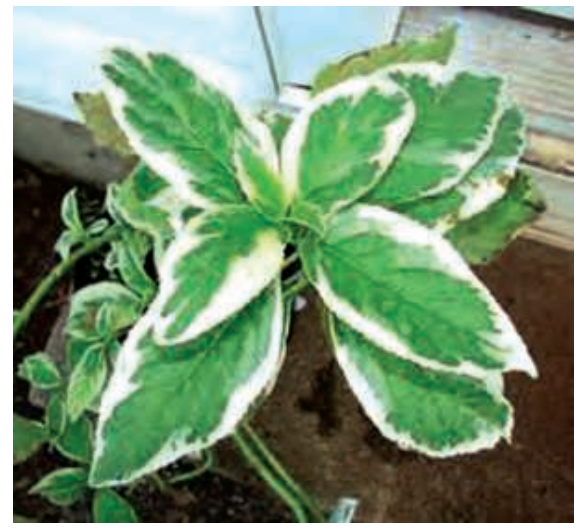
We will use a plant having variegated leaves in the next experiment to show that chlorophyll is necessary for the process of photosynthesis in plants.
KSEEB Class 10 SSLC Biology Experiment To Show That Chlorophyll Is Necessary For Photosynthesis
- We take a potted plant like croton whose leaves are partly green and partly white .The green part of the leaf has chlorophyll but the white part of the leaf does not have chlorophyll.
- Place this plant in a completely dark place for about three days to destarch its leaves.
- Take out the potted plant from the dark place and keep it in bright sunshine for three to four days.

- Pluck the variegated leaf from the plant, boil it in water for a few minutes and then remove its green colour ‘chlorophyll’ by boiling it in alcohol. The green parts of the leaf get decolourised. So, we get decolourised leaf
- Wash the decolourised leaf with hot water to soften it and remove any chlorophyll which may be sticking to it.
- Pour iodine solution over the colourless leaf and observe the change in colour of the leaf.
- We will find that the outer part of leaf that was originally white (without chlorophyll) does not turn blue-black on adding iodine solution showing that no starch is present in this outer part of the leaf From this observation we conclude that the photosynthesis to make starch does not take place without chlorophyll.
- The inner part of leaf which was originally green (contained chlorophyll) turns blue-black on adding iodine solution showing that starch is present in this inner part of the leaf.From this observation we conclude that the photosynthesis to make starch takes place in the presence of chlorophyll. In other words, chlorophyll is necessary for the process of photosynthesis to take place.
KSEEB Class 10 SSLC Biology Experiment To Show That Carbon Dioxide Is Necessary For Photosynthesis
- We take a potted plant having long and narrow leaves and place it in a completely dark place for about three days to destarch its leaves.
- Take a glass bottle having a wide mouth and put some potassium hydroxide solution (KOH solution) in it. (This potassium hydroxide solution is to absorb the carbon dioxide gas from the air present in the glass bottle so that no carbon dioxide is left in the air inside the glass bottle).
- Take a rubber cork which fits tightly into the mouth of the glass bottle and cut it into two halves.
- Put a destarched leaf of the potted plant (while it is still attached to the plant), in-between the two halves of the cut cork and then fit the cork in the mouth of the glass bottle. The upper half of the leaf should remain outside the glass bottle and only the lower half of the leaf should be inside the glass bottle
- The potted plant (with its one destarched leaf half inside the glass bottle containing potassium hydroxide solution) is kept in sunlight for 3 to 4 days. During this period, the upper half of the leaf (which is outside the glass bottle) gets carbon dioxide from the air but the lower half of the leaf (which is inside the glass bottle) does not get any carbon dioxide. This is because all the carbon dioxide of the air present in the glass bottle has been absorbed by potassium hydroxide solution.And no fresh air can come into the closed glass bottle. Carbon dioxide available here No carbon dioxide Potassium hydroxide solution (to absorb carbon dioxide)

- Pluck the leaf from the plant and take it out from the glass bottle. Remove the green coloured chlorophyll from the leaf by boiling it in alcohol. In this way, we get a decolourised leaf.
- Wash the decolourised leaf with water to remove any chlorophyll which may be sticking to it.
- Pour iodine solution over the colourless leaf and observe the change in colour of the leaf.
- We will find that the lower half part of the leaf (which was inside the glass bottle having no carbon dioxide around it), does not turn blue-black on adding iodine solution showing that no starch is present in this lower half of the leaf [see Figure 20(c)]. From this observation we conclude that the photosynthesis to make starch in the leaf does not take place without carbon dioxide.
- The upper half part of the leaf (which was outside the glass bottle, having carbon dioxide around it) turns blue-black on adding iodine solution showing that starch is present in this upper half of the leaf. From this observation we conclude that photosynthesis (to make starch) takes place in the presence of carbon dioxide. In other words, carbon dioxide is necessary for the process of photosynthesis to take place.
KSEEB Class 10 SSLC Biology Raw Materials For Photosynthesis
The preparation of carbohydrates (food) by plants by the process of photosynthesis requires two materials (or substances) : carbon dioxide, and water. Thus, the raw materials for photosynthesis are:
- Carbon dioxide, and
- water
We will now describe how these two raw materials become available to plants for photosynthesis.
KSEEB Class 10 SSLC Biology How The Plants Obtain Carbon Dioxide
There are a large number of tiny pores called stomata on the surface of the leaves of plants (The singular of stomata is stoma). The green plants take carbon dioxide from air for photosynthesis. The carbon dioxide gas enters the leaves of the plant through the stomata present on their surface .

- Each stomatal pore (or stoma) is surrounded by a pair of guard cells. The opening and closing of stomatal
- Chloroplast Surface of a leaf Guard cells (curved) Open stoma Guard cells (straight) Closed stoma
- Open stomata
- Closed stomata
- The plants take carbon dioxide required for photosynthesis from air through the stomata (tiny pores) present on the surface of a leaf. pores is controlled by the guard cells.
- When water flows into the guard cells, they swell, become curved and cause the pore to open .On the other hand, when the guard cells lose water, they shrink, become straight and close the stomatal pore.
- A large amount of water is also lost from the cells of the plant leaves through open stomatal pores. So, when the plant does not need carbon dioxide and wants to conserve water, the stomatal pores are closed. The oxygen gas produced during photosynthesis also goes out through the stomatal pores of the leaves.
- Please note that in addition to leaves, the stomata are also present in the green stems (or shoots) of a plant. So, the green stems (or shoots) of a plant also carry out photosynthesis. It is clear from the above discussion that stomata allow the movement of gases in and out of plant cells. In other words, the gaseous exchange in plants takes place through the stomata in leaves (and other green parts).
- Please note that in most broad-leaved plants, the stomata occur only in the lower surface of the leaf but in narrow-leaved plants, the stomata are equally distributed on both the sides of the leaf. Another point to be noted is that the aquatic plants (or water plants) use the carbon dioxide gas dissolved in water for carrying out photosynthesis.
- The stomata on the lower surface of a leaf as seen through a microscope.
KSEEB Class 10 SSLC Biology How The Plants Obtain Water For Photosynthesis
- The water required by the plants for photosynthesis is absorbed by the roots of the plants from the soil through the process of osmosis. The water absorbed by the roots of the plants is transported upward through the xylem vessels to the leaves where it reaches the photosynthetic cells and utilised in photosynthesis.
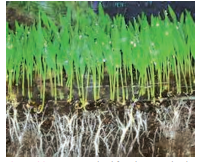
- The two raw materials, carbon dioxide and water, are required by the plants to prepare energy foods called carbohydrates (such as glucose and starch). But the plants also need other raw materials such as nitrogen, phosphorus, iron and magnesium, etc., for building their body.
- The plants take materials like nitrogen, phosphorus, iron and magnesium, etc., from the soil. For example, nitrogen is an essential element used by the plants to make proteins and other compounds.
- The plants take up nitrogen from the soil in the form of inorganic salts called nitrates (or nitrites), or in the form of organic compounds which are produced by bacteria from the atmospheric nitrogen.
KSEEB Class 10 SSLC Biology Site Of Photosynthesis Chloroplasts
- Chloroplasts are the organelles in the cells of green plants which contain chlorophyll and where photosynthesis takes place. Thus, photosynthesis occurs in the organelles called chloroplasts present in the photosynthetic cells (or mesophyll cells) of green plants.
- In other words, the site of photosynthesis in a cell of the leaf are chloroplasts. Chloroplasts can be seen easily by using a light microscope. In a cross- section of a leaf, chloroplasts can be seen as numerous disc-like organelles in the photosynthetic cells (or mesophyll cells) of the palisade tissue just below the upper epidermis
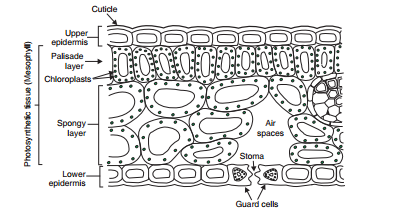
- Cuticle Photosynthetic tissue (Mesophy) Upper epidermis Palisade layer Chloroplasts Spongy- layer Lower epidermis.
- Water required for photosynthesis is absorbed by the roots of the plants from the soil.
- Air spaces Stoma Guard calls. The structure of a leaf to show chloroplasts in it (The small green circles in the above diagram are all chloroplasts).
- In the structure of a leaf we can see that the middle layers in the leaf (palisade layer and spongy layer) contain photosynthetic cells called mesophyll cells.
- These cells contain more chlorophyll than other plant cells. A typical photosynthetic cell (or mesophyll cell) of a green leaf may contain 100 or more tiny chloroplasts in it, and a whole leaf may contain many thousands of photosynthetic cells.
- Carbon dioxide needed for photosynthesis enters from the air into the leaf through the stomata in its surface and then diffuses into the mesophyll cells and reaches the chloroplasts.
- Water is carried to the leaf by xylem vessels and passes into the mesophyll cells by diffusion and reaches the chloroplasts.
- There is a thin, waxy protective layer called cuticle above and below a leaf which helps to reduce the loss of water from the leaf.
KSEEB Class 10 SSLC Biology Nutrition in Animals
- We have just studied the nutrition in plants. We have learnt that plants are autotrophic organisms which can manufacture their own food.
- So, plants don’t have to look to others for getting their food. They are food producers themselves. But this is not so in the case of animals.
- Animals are heterotrophs and hence they depend on other organisms for their food. Thus, animals need an external source of food. We will now discuss how animals obtain their food.
KSEEB Class 10 SSLC Biology Animals Obtain Their Food From Plants Or Other Animals
- Since animals cannot make their own food, they depend on readymade food.
- This readymade food comes either from ‘plants’ or from ‘other animals’. Thus, animals obtain their food from plants or other animals (which they eat). We (human beings) are also animals.
- We obtain the foods like wheat, rice, pulses (dal), fruits and vegetables from plants. And the foods like milk, curd, cheese and eggs are obtained from animals. Some people also eat meat, chicken and fish as food.
- These foods are also obtained from animals. Many other animals obtain their food by eating the flesh of other animals. For example, the fish, birds, snakes and insects, all obtain their food from other animals.
- The big fish eats small fish; the birds eat worms and insects; the snake eats frogs and the insects eat dead bodies of animals. The non-green plants also obtain their food from other plants and animals.

- Yeast plant is one such example. Even the plants can eat insects. For example, the pitcher plant and the venus fly-trap are the two plants which eat insects.
- All the animals can be divided into three groups on the basis of their food habits (or eating habits).
These are:
- Herbivores,
- Carnivores, and
- Omnivores.
We will now discuss herbivores, carnivores and omnivores in somewhat detail. Let us start with the herbivores.
“Detailed notes on Life Processes for Class 10 SSLC”
KSEEB Class 10 SSLC Biology Herbivores
Some animals eat only plants (or their products). Those animals which eat only plants are called herbivores. The herbivores may eat grasses, leaves, grains, fruits or the bark of trees. Some of the examples of herbivores are: Goat, Cow, Buffalo, Sheep, Horse, Deer, Camel, Ass, Ox, Elephant, Monkey, Squirrel, Rabbit, Grasshopper and Hippopotamus. Cow is called a herbivore because it eats only plants as food. Thus, herbivores are plant eaters. Herbivores are also called herbivorous animals.

KSEEB Class 10 SSLC Biology Carnivores
Some animals eat only other animals. They do not eat plant food at all. Those animals which eat only other animals as food are called carnivores. Carnivores eat only the meat (or flesh) of other animals. So, we can also say that: Those animals which eat only the meat (or flesh) of other animals are called carnivores. Some of the examples of carnivores are: Lion, Tiger, Frog, Vulture, Kingfisher, Lizard, Wolf, Snake and Hawk. Lion is called a carnivore because it eats only the meat (or flesh) of other animals like deer, rabbit, goat, etc. Thus, carnivores are meat eaters. Carnivores are also called carnivorous animals.
KSEEB Class 10 SSLC Biology Omnivores
- Some animals eat both, plants as well as other animals as food. Those animals which eat both, plants and animals, are called omnivores.
- In other words, the omnivores eat plant food as well as the meat (or flesh) of other animals. Some of the examples of omnivores are: Man (Human beings), Dog, Crow, Sparrow, Bear, Mynah, and Ant.
- Man is called an omnivore because he eats the plant food (such as grains, pulses, fruits and vegetables) as well as the meat of animals (such as goat, chicken and fish).
- Thus, omnivores are plant eaters as well as meat eaters. Omnivores are also called omnivorous animals.
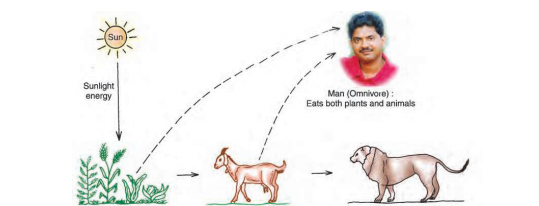
- All the living things on earth actually depend on the sun for their food.
- Plants use the energy of sun and prepare food by photosynthesis. The plants utilise this food for maintaining their life. These plants (and their products) are also eaten up by herbivores and omnivores as food.
- And the carnivores eat herbivores as food. In this way, it is the energy of the sun which provides food for plants, and animals (herbivores, carnivores and omnivores). the goat is a herbivore which eats plants; man is an omnivore who eats both, plants and meat of goat; and lion is a carnivore which eats the flesh of goat (The man usually does not get eaten up by lion because he is a very clever fellow!).
- An organism either makes its own food from raw materials as green plants do or takes in readymade food as animals do. The process of obtaining food and then using it for obtaining energy, growth and repair of the body, is called nutrition. We will now discuss the animal nutrition in detail.
KSEEB Class 10 SSLC Biology Different Steps In The Process Of Nutrition In Animals
There are five main processes concerned with the use of food by animals. In other words, there are five steps in the process of nutrition in animals. These are: Ingestion, Digestion, Absorption, Assimilation and Egestion. All these steps are discussed below:
Ingestion
In order to provide the energy necessary for growth and carry on life’s activities, we must ‘eat food’ or ‘take food into the body. The process of taking food into the body is called ingestion. In most simple terms, ingestion means ‘eating of food’ by the animal. we put food into our mouth with hands, we are ingesting (the food).
Digestion
- The food of most animals consists of large insoluble molecules which cannot be absorbed by the animal’s body in this form. So, before the food can be used by the animal for various functions like getting energy or for growth, it must be broken down into small, water soluble molecules which can be absorbed by the body.
- The process in which the food containing large, insoluble molecules is broken down into small, water soluble molecules (which can be absorbed by the body) is called digestion. In most simple terms, digestion is the dissolving of the solid food.
- Digestion makes the food soluble so that it can be utilised by the animal’s body. Most animals use both, physical and chemicalmethods for digesting (breaking up) the large food molecules.
- Physical methods include chewing and grinding the food in mouth and chemical methods include the addition of digestive juices(enzymes) to food by the body itself.
Absorption
- Our food contains very big molecules of carbohydrates (like starch), fats and proteins which cannot be absorbed in the body as such.
- They must be broken down into small, water soluble molecules which can be absorbed by the body. This happens in the process of digestion.
- After digestion, the food molecules become small and soluble. The soluble food molecules can pass through the walls of our intestine and go into blood.
- The process in which the digested food passes through the intestinal wall into blood stream is called absorption.
Assimilation
- Blood carries the absorbed food to all the parts of the body. The food then enters each and every cell of the body where it is used for producing energy and for making materials for the growth and repair of the body. The process in which the absorbed food is taken in by body cells and used for energy, growth and repair, is called assimilation.
Egestion
- The whole food which we eat is not digested by our body. A part of the food which we eat remains undigested (or insoluble) which cannot be used by the body.
- This undigested part of the food is then removed from the body in the form of faeces when we go to toilet. The process in which the undigested food is removed from the body is called egestion.
KSEEB Class 10 SSLC Biology Nutrition In Simple Animals
- Amoeba and Paramecium are two very simple animals. The body of each one of them consists of a single cell only. They are called unicellular animals.
- In unicellular animals, all the processes of nutrition are performed by the single cell.
- This point will become more clear from the following example of the nutrition in Amoeba.
Nutrition in Amoeba
Amoeba is a unicellular animal. Amoeba eats tiny (microscopic) plants and animals as food which float in water in which it lives. The mode of nutrition in Amoeba is holozoic. The process of obtaining food by Amoeba is called phagocytosis (Phagocytosis’ means ‘cell feeding). The various steps involved in the nutrition of Amoeba are: ingestion, digestion, absorption, assimilation, and egestion. All the processes of nutrition are performed by the single cell of Amoeba. This is described below.

Ingestion
- Amoeba has no mouth or a fixed place for the ingestion of food (intake of food). Amoeba ingests food by using its pseudopodia.
- When a food particle comes near Amoeba, then Amoeba ingests this food particle by forming temporary finger-like projections called pseudopodia around it.
- The food is engulfed with a little surrounding water to form a food vacuole inside the Amoeba.
- This food vacuole can be considered to be a ‘temporary stomach’ of Amoeba.
KSEEB SSLC Chapter 1 Life Processes important topics”
Digestion
- In Amoeba, food is digested in the food vacuole by digestive enzymes.
- The enzymes from surrounding cytoplasm enter into the food vacuole and break down the food into small and soluble molecules by chemical reactions.
- Thus, digestion in Amoeba takes place inside the food vacuole due to which the food dissolves (or food becomes soluble).
Absorption
- The digested food present in the food vacuole of Amoeba is absorbed directly into the cytoplasm of Amoeba cell by diffusion.
- Since Amoeba consists of only one small cell, it does not require blood system to carry the digested food.
- The digested food just spreads out from the food vacuole into the whole of Amoeba cell. After absorption of food, the food vacuole disappears.
Assimilation
- A part of the food absorbed in Amoeba cell is used to obtain energy through respiration.
- The remaining part of absorbed food is used to make the parts of Amoeba cell which lead to the growth of Amoeba.
- Thus, on assimilating food Amoeba grows in size. And then Amoeba can reproduce by dividing into two daughter cells.
Egestion
- Amoeba has no fixed place (like anus) for removing the undigested part of food.
- When a considerable amount of undigested food collects inside Amoeba, then its cell membrane suddenly ruptures at any place and the undigested food is thrown out of the body of Amoeba .
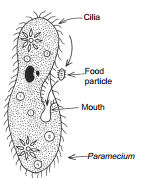
- Paramecium is also a tiny unicellular animal which lives in water. Paramecium uses its hair like structures called cilia to sweep the food particles from water and put them into its mouth.
- The Paramecium has thin, hair-like cilia all over its body. The cilia move back and forth rapidly in water. When the cilia present around the mouth region of Paramecium move back and forth, they sweep the food particles present in water into the mouth of Paramecium.
- This is the first step in the nutrition of Paramecium which is called ingestion. Ingestion is followed by other steps such as digestion, absorption, assimilation and egestion (as explained in the case of Amoeba).
KSEEB Class 10 SSLC Biology Nutrition In Complex Multicellular Animals
- In the complex multicellular animals like man (humans), grasshopper, fish and frog, etc., all the processes involved in nutrition are performed by a combination of digestive organs.
- This combination of digestive organs is called digestive system. We will now describe all the processes in the nutrition of complex multicellular animals by taking the example of nutrition in human beings.
- Please note that a long tube running from mouth to anus of a human being (or other animals) in which digestion and absorption of food takes place is called alimentary canal. Alimentary canal is also called ‘gut’. Let us now study the nutrition in human beings.
KSEEB Class 10 SSLC Biology Nutrition In Human Beings
- The nutrition in human beings (or man) takes place through human digestive system. The human digestive system consists of the alimentary canal and its associated glands.
- The various organs of the human digestive system in sequence are: Mouth, Oesophagus (or Food pipe), Stomach, Small intestine and Large intestine.
- The glands which are associated with the human digestive system and form a part of the human digestive system are: Salivary glands, Liver and Pancreas.
- The human alimentary canal which runs from mouth to anus is about 9 metres long tube. The ducts of various glands open into the alimentary canal and pour the secretions of the digestive juices into the alimentary canal.
- The human digestive system We will now describe the various steps of nutrition in human beings (or man).
Ingestion
- The human beings have a special organ for the ingestion of food. It is called mouth. So, in human beings, food is ingested through the mouth. The food is put into the mouth with the help of hands.
Digestion
- In human beings, the digestion of food begins in the mouth itself. In fact, the digestion of food starts as soon as we put food in as we put food in our mouth. our mouth. This happens as follows:
- The mouth cavity (or buccal cavity) contains teeth, tongue, and salivary glands. The teeth cut the food into small pieces, chew and grind it. So, the teeth help in physical digestion. The salivary glands in our mouth produce saliva.
- Our tongue helps in mixing this saliva with food. Salivais a watery liquid so it wets the food in our mouth. The wetted food can be swallowed more easily. Many times we have observed that when we see or eat a food which we really like, our mouth ‘waters’.
- This watering of mouth is due to the production of saliva by the salivary glands in the mouth. The salivary glands help in chemical digestion by secreting enzymes. The human saliva contains an enzyme called salivary amylase which digests the starch present in food into sugar.
- Thus, the digestion of starch (carbohydrate) begins in the mouth itself. Since the food remains in the mouth only for a short time, so the digestion of food remains incomplete in mouth.
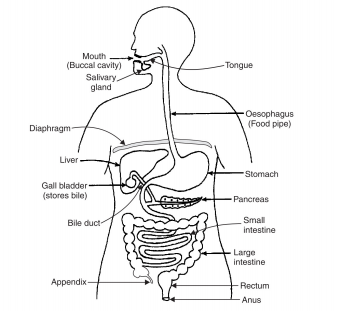
- The slightly digested food in the mouth is swallowed by the tongue and goes down the food pipe called oesophagus.
- The oesophagus carries food to the stomach. This happens as follows: The walls of food pipe have muscles which can contract and expand alternately.
- When the slightly digested food enters the food pipe, the walls of food pipe start contraction and expansion movements.
- The contraction and expansion movement of the walls of food pipe is called peristaltic movement. This peristaltic movement of food pipe (or oesophagus) pushes the slightly digested food into the stomach (In fact, the peristaltic movement moves the food in all the digestive organs throughout the alimentary canal).
- The stomach is a J-shaped organ present on the left side of theabdomen. The food is further digested in the stomach.
- The food is churned in the stomach for about three hours. During this time, the food breaks down into still smaller pieces and forms a semi-solid paste.
- The stomach wall contains three tubular glands in its walls. The glands present in the walls of the stomach secrete gastric juice. The gastric juice contains three substances : hydrochloric acid, the enzyme pepsin and mucus. Due to the presence of hydrochloric acid, the gastric juice is acidic in nature.
- In the acidic medium, the enzyme pepsin begins the digestion of proteins present in food to form smaller molecules. Thus, the protein digestion begins in the stomach.
- Please note that the protein digesting enzyme pepsin is active only in the presence of an acid. So, the function of hydrochloric acid in the stomach is to make the medium of gastric juice acidic so that the enzyme pepsin can digest the proteins properly.
- Another function of hydrochloric acid is that it kills any bacteria which may enter the stomach with food. The mucus helps to protect the stomach wall from its own secretions of hydrochloric acid.
- If mucus is not secreted, hydrochloric acid will cause the erosion of inner lining of stomach leading to the formation of ulcers in the stomach. The partially digested food then goes from the stomach into the small intestine.
- The exit of food from stomach is regulated by a ‘sphincter muscle’ which releases it in small amounts into the small intestine.
From the stomach, the partially digested food enters the small intestine.
- The small intestine is thelargest part of the alimentary canal. It is about 6.5 metres long in an adult man. Though the small intestine is very long, it is called small intestine because it is very narrow. The small intestine is arranged in the form of a coil in our belly Please note that the length of the small intestine differs in various animals depending on the type of food they eat.
- For example, cellulose is a carbohydrate food which is digested with difficulty. So, the herbivorous animals like cow which eat grass need a longer ‘small intestine to allow the cellulose present in grass to be digested completely. On the other hand, meat is a food which is easier to digest. So, the carnivorous animals like tigers which eat meat have a shorter ‘small intestine”.
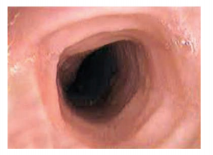
The small intestine in human beings is the site of complete digestion of food (like carbohydrates, proteins and fats). This happens as follows:
- The small intestine receives the secretions of two glands: liver and pancreas. Liver secretes bile. Bile is a greenish yellow liquid made in the liver which is normally stored in the gall bladder. Bile is alkaline, and contains salts which help to emulsify or break the fats (or lipids) present in the food. Thus, bile performs two functions:
- makes the acidic food coming from the stomach alkaline so that pancreatic enzymes can act on it, and
- bile salts break the fats present in the food into small globules making it easy for the enzymes to act and digest them.
- Pancreas is a large gland which lies parallel to and beneath the stomach Pancreas secretes pancreatic juice which contains digestive enzymes like pancreatic amylase, trypsin and lipase. The enzyme amylase breaks down the starch, the enzyme trypsin digests the proteins and the enzyme lipase breaks down the emulsified fats.
- The glands in the walls of the stomach secrete gastric juice containing hydrochloric acid, enzyme pepsin and mucus.
- Liver secretes bile into the small Pancreas secretes pancreatic intestine. We can also see the gall bladder in juice into the small intestine which contains this picture which stores bile. three digestive enzymes: pancreatic amylase, trypsin and lipase.
- The walls of small intestine contain glands which secrete intestinal juice.
- The intestinal juice contains a number of enzymes which complete the digestion of complex carbohydrates into glucose, proteins into amino acids and fats into fatty acids and glycerol. Glucose, amino acids, fatty acids and glycerol are small, water soluble molecules.
- In this way, the process of digestion converts the large and insoluble food molecules into small, water soluble molecules.
- The chemical digestion of food is brought about by biological catalysts called enzymes.
Absorption
- After digestion, the molecules of food become so small that they can pass through the walls of the small intestine (which contain blood capillaries) and go into our blood.
- This is called absorption. The smallintestine is the main region for the absorption of digested food.
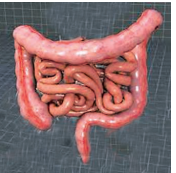

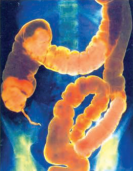
- In fact, the small intestine is especiallyadapted for absorbing the digested food. The inner surface of small intestine has millions of tiny, finger- like projections called villi.
- The presence of villi gives the inner walls of the small intestine a very large surface area. And the large surface area of small intestine helps in the rapid absorption of digested food.
- The digested food which is absorbed through the walls of the small intestine, goes into our blood. The narrow tube in this picture is the small intestine whereas the wider tube is the large intestine.
- Villi are present on the inner surface of small intestine. They help in absorbing digested food into the blood of a person.
- The X-ray photograph of large intestine taken after the person had been given a barium meal.
Assimilation
- The blood carries digested and dissolved food to all the parts of the body where it becomes assimilated as part of the cells.
- This assimilated food is used by the body cells for obtaining energy as well as for growth and repair of the body.
- The energy is released by the oxidation of assimilated food in the cells during respiration.
- The digested food which is not used by our body immediately is stored in the liver in the form of a carbohydrate called “glycogen’.
- This stored glycogen can be used as a source of energy by the body as and when required.
Egestion
- A part of the food which we eat cannot be digested by our body. This undigested food cannot be absorbed in the small intestine.
- So, the undigested food passes from the small intestine into a wider tube called large intestine (It is called large intestine because it is a quite wide tube).
- The walls undigested part of food becomes almost solid. The last part of the large intestine called ‘rectum’ storesthis undigested food for some time.
- And when we go to the toilet, then this undigested food is passed out(or egested) from our body through anus as faeces or ‘stool’ The act of expelling the faecesis called egestion or defecation. The exit of faeces is controlled by the anal sphincter.
1 mL of very dilute starch solution (1% starch solution) is taken in a test-tube and1 mL of saliva is added to it. After keeping this mixture for half an hour, a few drops of dilute iodine solution are added to the test-tube. There is no change in colour on adding iodine solution. What does thistell you about the action of saliva on starch?
When a mixture of dilute starch solution andsaliva is kept in a test-tube for half an hour, itdoes not produce a blue-black colour with iodine solution showing that no starch is left in the test-tube.
This tells us that the action of saliva has broken down starch into some other substance which does notgive any colour with iodine solution. Actually, saliva contains an enzyme ‘amylase’ which converts starch into a sugar.
KSEEB Class 10 SSLC Biology Dental Caries
- The hard, outer covering of a tooth is called enamel.Tooth enamel is the hardest materialinour body.
- It is harder than even bones. The part of tooth below enamel is called dentine. Dentine is
- The formation of small cavities (or holes) in the teeth due to the action of acid-forming bacteria and improperdental care is called dental caries.
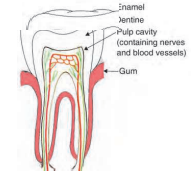
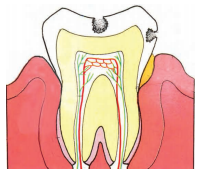
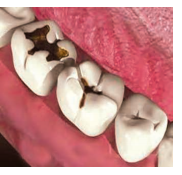
- When we eat sugary food, the bacteria in our mouth act on sugar to produce acids. These acids first dissolve the calcium salts from the tooth enamel and then from dentine forming small cavities (or holes) in the tooth over a period of time.
- The formation of cavities reduces the distance between the outside of the tooth and the pulp cavity which contains nerves and blood vessels.
- The acids produced by bacteria irritate the nerve endings inside the tooth and cause toothache.
- If the cavities caused by dental decay are not cleaned and filled by a dentist, the bacteria will get into the pulp cavity of tooth causing inflammation and infection leading to severe pain.
- If the teeth are not cleaned regularly, they become covered with a sticky, yellowish layer of food particles and bacteria cells called ‘dental plaque’. Since plaque covers the teeth forming a layer over them, the alkaline saliva cannot reach the tooth surface to neutralise the acid formed by bacteria and hence tooth decay sets in.
- Brushing the teeth regularly, after eating food, removes the plaque before bacteria produces acids. This will prevent dental caries or tooth decay. Before we go further and discuss respiration.
KSEEB Class 10 SSLC Biology Respiration
We have just studied that digested food is assimilated into the body of the living organisms. The assimilated food is used mainly for two purposes :
Assimilated food is used as a fuel to get energy for various life processes, and
Assimilated food is used as a material for the growth and repair of the body.
- We will now describe how energy is released from the food which is absorbed and assimilated in the cells of the body. Please note that food is the ‘fuel’ for energy production in cells. Let us see how energy is actually obtained.
- Most living things need oxygen (of air) to obtain energy from food. This oxygen reacts with the food molecules (like glucose) present in the body cells and burns them slowly to release energy.
- The energy thus released is stored in ATP molecules in the cells. The body can use this stored energy whenever it wants to do so.
- The process of releasing energy from food is called respiration. When oxygen burns the food in the cells of the body to release energy, then carbon dioxide and water are produced as waste products which are to be eliminated from the body.
- The process of respiration involves taking in oxygen (of air) into the cells, using it for releasing energy by burning food, and then eliminating the waste products (carbon dioxide and water) from the body. The process of respiration can be written in the form of a word equation as follows :
- Food + Oxygen o Carbon dioxide + Water + Energy
- The process of respiration which releases energy takes place inside the cells of the body. So, it is also known as cellular respiration. The process of cellular respiration is common to all the living organisms.
- It provides energy to the cells. There are two by-products of cellular respiration : carbon dioxide and water. Out of these only carbon dioxide is considered the real waste product of respiration because its accumulation in the body is harmful to the organism.
- Water produced during respiration is not harmful to the body. It is rather beneficial for the body.
- Please note that respiration is essential for life because it provides energy for carrying out all the life processes which are necessary to keep the organisms alive.
KSEEB Class 10 SSLC Biology Breathing And Respiration
- The mechanism by which organisms obtain oxygen from the air and release carbon dioxide is calledbreathing. Respiration is a more complex process.
- Respiration includes breathing as well as the oxidation of food in the cells of the organism to release energy.
- Breathing is a physical process whereas respiration also includes biochemical process of oxidation of food.
- The process of breathing involves the lungs of the organism whereas the process of respiration also involves the mitochondria in the cells where food is oxidised to release energy.
- Respiration is actually a biochemical process which occurs in stages and requires many enzymes.
- Themain purpose of respiration is the release of energy from the oxidation of simple food molecules like glucose. The energy released during respiration is used for carrying out the biological functions which are necessary for the maintenance of life and survival of an organism.
- Please note that respiration is just opposite of photosynthesis. This is because photosynthesis makes food (like glucose) by using carbon dioxide, water and sunlight energy, and releasing oxygen; whereas respiration breaks food (like glucose) by using oxygen, and releasing carbon dioxide, water and energy.
KSEEB Class 10 SSLC Biology How Energy Released During Respiration Is Stored
- All the energy released during respiration is not used immediately by an organism (plant or animal). The energy produced during respiration is stored in the form of ATP molecules in the cells of the body and used by the organism as and when required.
- In order to understand this we should first know the meaning of ADP, ATP and inorganic phosphate. These are given below. ADP is a substance called Adenosine Di-Phosphate. The molecules of ADP are present in a cell. ADP has low energy content.
- ATP is a substance called Adenosine Tri-Phosphate. It is also present inside a cell. ATP has a high energy content. Inorganic phosphate is a substance which contains a phosphate group made up of phosphorus and oxygen. Inorganic phosphates are also present in a cell. Inorganic phosphate can be represented by writing just ‘Phosphate’. The inorganic phosphate can also be represented by the symbol Pi (where P stands for phosphate and i for inorganic).
- ADP contains two phosphate groups whereas ATP contains three phosphate groups in its molecule.
The energy released during respiration is used to make ATP molecules from ADP and inorganic phosphate. This happens as follows : ADP combines with inorganic phosphate by absorbing the energy released during respiration to form ATP molecules. That is :


- The energy equivalent to 30.5 kJ/mole is released in this process. The energy released by ATP is used to carry out all the endothermic reactions taking place in the cells.
- Please note that ADP can be converted to ATP by absorbing energy produced during respiration, and ATP can be converted back to ADP releasing energy to be used by the cells, again and again.
- This ensures a continuous supply of energy to the organism. Just as a battery can provide electrical energy for different purposes such as lighting, heating, running radio and computer, etc., in the same way, the energy stored in ATP is used by the body cells for various purposes like contraction of muscles, conduction of nerve impulses, synthesis of proteins, and many other activities related to the functioning of cells. In fact, ATP is known as the energy currency of cells.
KSEEB Class 10 SSLC Biology An Important Discussion
In most of the cases, the organisms (plants and animals) carry out respiration by using oxygen (called aerobic respiration). There are, however, some organisms which carry out respiration without using oxygen (called anaerobic respiration). Before we describe aerobic respiration and anaerobic respiration, we should keep the following points in mind which will help us in understanding the two types of respiration.
- Glucose is C6H12O6. It is a six carbon atom compound. It is the simple food which is oxidised in the cells of organisms during respiration.
- The oxidation of glucose to pyruvic acid (or pyruvate) is called glycolysis. It occurs in the cytoplasm of a cell and not in mitochondria. The oxidation of glucose to pyruvic acid does not require oxygen. One molecule of glucose on glycolysis produces two molecules of pyruvic acid (or pyruvate).
- Pyruvic acid is a three carbon atom compound. It is also called pyruvate. The formula of pyruvic acid or pyruvate is . It is a ketonic carboxylic acid.
- The fate of pyruvate formed during respiration depends on whether oxygen is present in the cells or not. If oxygen is present in the cells, then pyruvate is completely oxidised to carbon dioxide and water, and a lot of energy is produced (in the form of ATP). If, however, oxygen is not present in the cells (that is, in the absence of oxygen), pyruvate is converted to either ‘ethanol and carbon dioxide’ or ‘lactic acid’ depending on whether such a process is taking place in a plant cell or an animal cell. Much less energy is released in this case.
- Lactic acid is also a three carbon atom compound. It is also called lactate. The formula of lactic acid or lactate is . It is a hydroxy carboxylic acid.
KSEEB Class 10 SSLC Biology Types of Respiration
So far we have studied that respiration takes place in the presence of oxygen (of air). Respiration can, however, also take place in the absence of oxygen (of air), though it is very rare. This means that oxidation of food to obtain energy can occur in the presence of oxygen as well as in the absence of oxygen. Based on this, we have two types of respiration : aerobic respiration and anaerobic respiration.
KSEEB Class 10 SSLC Biology Aerobic Respiration
- The respiration which uses oxygen is called aerobic respiration. It is called aerobic respiration because it uses air which contains oxygen (‘aerobic’ means ‘with air’).
- In aerobic respiration, the glucose food is completely broken down into carbon dioxide and water by oxidation. Aerobic respiration produces a considerable amount of energy for use by the organism which gets stored in the ATP molecules.
- The breaking down of glucose (food) during aerobic respiration (which is carried out by most of the organisms) can be represented as follows :

- Please note that during aerobic respiration (shown above), 1 molecule of glucose (food) produces 38 energy-rich ATP molecules (Please do not worry about the name ‘Kreb’s cycle’ written in the above equation.
- We will study this in higher classes). All the organisms which obtain energy by aerobic respiration, cannot live without oxygen (of air).
- This is because if there is no oxygen, they cannot get energy from the food which they eat. Mitochondria are the sites of aerobic respiration in the cells .
- Thus, the breakdown of pyruvate to give carbon dioxide, water and energy takes place in mitochondria.

- The energy released during aerobic respiration is used by the organism. Most of the living organisms carry out aerobic respiration (by using oxygen of air).
- For example, humans (man), dogs,cats, lions, elephants, cows, buffaloes, goat, deer, birds, lizards, snakes, earthworms, frogs, fish, and insects (such as cockroach, grasshopper, houseflies, mosquitoes and ants, etc.) and most of the plants carry out aerobic respiration by using oxygen of air (to obtain energy).
KSEEB Class 10 SSLC Biology Anaerobic Respiration
- The respiration which takes place without oxygen is called anaerobic respiration. It is called anaerobic respiration because it takes place without air which contains oxygen (‘anaerobic’ means ‘without air’).
- The microscopic organisms like yeast and some bacteria obtain energy by anaerobic respiration (which is called fermentation).
- In anaerobic respiration, the micro-organisms like yeast break down glucose (food) into ethanol and carbon dioxide, and release energy.
- This energy is then used by the micro-organisms.
- Anaerobic respiration produces much less energy which gets stored in the ATP molecules. The breaking down of glucose (food) during anaerobic respiration carried out by yeast (plants) can be represented as follows :

- Please note that during anaerobic respiration (shown above), 1 molecule of glucose (food) produces only 2 energy-rich ATP molecules. A few organisms such as yeast plants and certain bacteria (called anaerobic bacteria) can obtain energy from food in the absence of oxygen by the process of anaerobic respiration.
- Please note that all the organisms which obtain energy by anaerobic respiration can live without oxygen (of air).
- For example, the single-celled, non-green plant called ‘yeast’ can live without oxygen because it obtains energy by the process of anaerobic respiration.
- From this discussion we conclude that all the cells do not use oxygen to produce energy. Energy can be produced in cells even without oxygen.
- Please note that the whole process of anaerobic respiration takes place in the cytoplasm of cells.
- We can carry out the fermentation of sugar by using the anaerobic respiration of yeast as follows :
- Take some sugar solution (or fruit juice) in a test-tube and add a little of yeast to it. Close the mouth of the test-tube with a cork and allow it to stand for some time. Now, open the cork and smell.
- A characteristic smell of ethanol (ethyl alcohol) is obtained from the test-tube. A gas is also evolved during this process.
- When this gas is passed through lime-water, the lime-water turns milky showing that it is carbon dioxide gas. This experiment tells us that the products of fermentation of sugar brought about by yeast are ethanol and carbon dioxide.
- We (the human beings) obtain energy by aerobic respiration. But anaerobic respiration can sometimes take place in our muscles (or the muscles of other animals).
- For example, anaerobic respiration takes place in our muscles during vigorous physical exercise when oxygen gets used up faster in the muscle cells than can be supplied by the blood.
- When anaerobic respiration takes place in human muscles (or animal muscles), then glucose (food) is converted into lactic acid with the release of a small amount of energy.
- The breaking down of glucose (food) during anaerobic respiration in muscles can be represented as follows :

- The sudden build up of lactic acid in our muscles during vigorous physical activity can cause muscular ‘cramps’. (The painful contractions of muscles are called cramps). Let us discuss this in a little more detail.
- During heavy physical exercise (or any other heavy physical activity), most of the energy in our muscles in produced by aerobic respiration.
- Anaerobic respiration in muscles provides only some extra energy which is needed under the conditions of heavy physical activity (like running very fast or running for a long time) (see the people running a long distance race).
- The anaerobic respiration by muscles brings about partial breakdown of glucose (food) to form lactic acid. This lactic acid accumulates in the muscles.
- The accumulation of lactic acid in the muscles causes muscle cramps. Thus, muscle cramps occur due to the accumulation of lactic acid in muscles when the muscles respire anaerobically (without oxygen) while doing hard physical exercise.
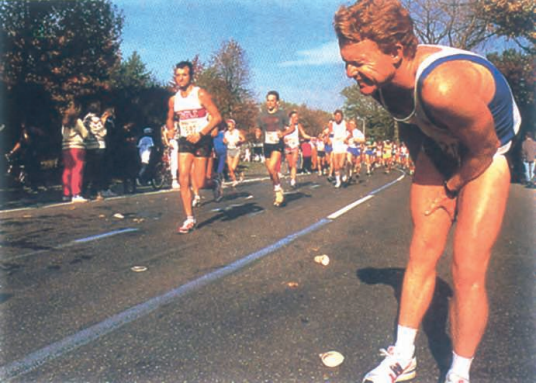
- We can get relief from cramps in muscles caused by heavy exercise by taking a hot water bath or a massage. Hot water bath (or massage) improves the circulation of blood in the muscles.
- Due to improved blood flow,the supply of oxygen to the muscles increases. Thisoxygen breaks down lactic acid accumulated in muscles into carbon dioxide and water, and hence gives us relief from cramps.
- The anaerobic respiration does not take place only in the muscles of human beings, it also takes place in the muscles of other animals such as lion, tiger, cheetah, deer, and many other animals.

- when they run very fast and require much more energy than normal. This means that even the animals likelion, tiger, cheetah and deer, etc., can get leg cramps due to the accumulation of lactic acid in leg muscles if they run very fast for a considerable time. Please note that :
- the anaerobic respiration in plants (like yeast) produces ethanol and carbon dioxide as end products.
- the anaerobic respiration in animal muscle tissue produces lactic acid as the end product.
- The similarity between aerobic respiration and anaerobic respiration is that in both the cases, energy is produced by the breakdown of food like glucose. The main differences between aerobic respiration and anaerobic respiration are given below.
“Life Processes Class 10 SSLC exam preparation”
KSEEB Class 10 SSLC Biology Differences Between Aerobic And Anaerobic Respiration
Aerobic respiration
- Aerobic respiration takes place in the presence of oxygen.
- Complete breakdown of food occurs in aerobic respiration.
- The end products in aerobic respiration are carbon dioxide and water.
- Aerobic respiration produces a considerable amount of energy.
Anaerobic respiration
- Anaerobic respiration takes place in the absence of oxygen.
- Partial breakdown of food occurs in anaerobic respiration.
- The end products in anaerobic respiration may be ethanol and carbon dioxide (as in yeast plants), or lactic acid (as in animal muscles).
- Much less energy is produced in anaerobic respiration. Let us answer one question now.
Sample Problem. The breakdown of pyruvate to give carbon dioxide, water and energy takes place in :
- cytoplasm
- mitochondria
- chloroplast
- nucleus
Answer. mitochondria
KSEEB Class 10 SSLC Biology Respiration in Plants
Like animals, plants also need energy. The plants get this energy by the process of respiration. Plants also use oxygen of air for respiration and release carbon dioxide. Thus, the respiration in plants also involves the exchange of oxygen and carbon dioxide.So, oxygen and carbon dioxide are called respiratory gases. Therespiration in plants differs from that in animals in three respects :
- All the parts of a plant (like root, stem and leaves) perform respiration individually. On the other hand, an animal performs respiration as a single unit.
- During respiration in plants, there is a little transport of respiratory gases from one part of the plant to the other. On the other hand, respiratory gases are usually transported over long distances inside an animal during respiration.
- The respiration in plants occurs at a slow rate. On the other hand, the respiration in animals occurs at a much faster rate.
KSEEB Class 10 SSLC Biology Plants Get Oxygen By Diffusion
Plants have a branching shape, so they have quite a large surface area in comparison to their volume. Therefore, diffusion alone can supply all the cells of the plants with as much oxygen as they need for respiration. Diffusion occurs in the roots, stems and leaves of plants.
KSEEB Class 10 SSLC Biology Respiration In Roots
- Air is present in-between the particles of soil. The roots of a plant take the oxygen required for respiration from the air present in-between the soil particles by the process of diffusion.
- The extensions of the epidermal cells of a root are called root hair. The root hair are in contact with the air in the soil. Oxygen (from air in the soil particles) diffuses into root hairs and reaches all the other cells of the root for respiration.
- Carbondioxide gas produced in the cells of the root during respiration moves out through the same root hairs by the process of diffusion. Thus, the respiration in roots occurs by the diffusion of respiratory gases (oxygen and carbon dioxide) through the root hairs.
- It has been found that the land plants die if their roots remain waterlogged for a considerable time. This is because too much water expels all the air fromin-between the soil particles.
- Due to this, oxygen is not available to the roots for aerobic respiration. Under these conditions, the roots will respire anaerobically, producing alcohol. This may kill the plant.
- In order to understand the respiration in stems of plants we should remember that the soft stems of small, herbaceous plants have stomata in them whereas the hard and woody stems of large plants and trees have lenticels in them.
- Lenticel is a small area of bark in a woody stem where the cells are loosely packed allowing the gaseous exchange to take place between the air and the living cells of the stem.
KSEEB Class 10 SSLC Biology Respiration In Stems
- The stems of herbaceous plants (or herbs) have stomata. So, the exchange of respiratory gases in the stems of herbaceous plants takes place through stomata.
- The oxygen from air diffuses into the stem of a herbaceous plant through stomata and reaches all the cells for respiration.

- The carbon dioxide gas produced during respiration diffuses out into the air through the same stomata. The hard and woody stems of big plants or trees do not have stomata. In woody stems, the bark (outer covering of stem) has lenticels for gaseous exchange.
- The oxygen from air diffuses into the stem of a woody plant through lenticels and reaches all the inner cells of the stem for respiration.
- The carbon dioxide gas produced in thecells of the stem during respiration diffuses out into the air through the same lenticels.
KSEEB Class 10 SSLC Biology Respiration In Leaves
- The leaves of a plant have tiny pores called stomata.The exchange of respiratory gases in the leaves takes place by the process of diffusion through stomata.
- Oxygen from air diffuses into a leaf through stomata and reaches all the cells where it is used in respiration.
- The carbon dioxide produced during respiration diffuses out from the leaf into the air through the same stomata.
- It should be noted that respiration in leaves occurs during the day time as well as at night. On the other hand, photosynthesis occurs only during the day time (no photosynthesis occurs at night).
- Due to this, the net gaseous exchange in the leaves of a plant is as follows :
- During day time, when photosynthesis occurs, oxygen is produced. The leaves use some of this oxygen for respiration and the rest of oxygen diffuses out into air. Again, during day time, carbon dioxide produced by respiration is all used up in photosynthesis by leaves. Even more carbon dioxide is taken in from air. Thus, the net gas exchange in leaves during day time is : O2 diffuses out ; CO2 diffuses in.
- At night time, when no photosynthesis occurs and hence no oxygen is produced, oxygen from air diffuses into leaves to carry out respiration. And carbon dioxide produced by respiration diffuses out into air. So, the net gas exchange in leaves at night is : O2 diffuses in; CO2 diffuses out.
KSEEB Class 10 SSLC Biology Respiration In Animals
Different animals have different modes of respiration. For example :
- In simple unicellular animals like Amoeba, respiration takes place by the simple diffusion of gases through the cell membrane. Most of the animals have, however, specific organs for respiration.
- The animals like earthworms which live in the soil use their skin to absorb oxygen from air and remove carbon dioxide. So, the respiratory organ in the earthworm is the skin.
- The aquatic animals like fish, prawns and mussels have gills as the respiratory organs which extract oxygen dissolved in water and take away carbon dioxide from the body.
- In the insects like grasshopper, cockroach, housefly and a mosquito, the tiny holes called spiracles on their body and the air tubes called tracheae are the respiratory organs.

- Grasshopper (an insect) breathes and respires through tiny holes called spiracles, air tubes called tracheae and their branches called tracheoles.
- The respiratory organs of the land animals such as man (humans), birds, lizard, dog, and frog, etc., are the lungs. (Frogs, however, breathe both by lungs and skin). Once the air (containing oxygen) enters the skin or lungs, blood absorbs the oxygen and transports it to various tissues of the animal. Blood also picks up the carbon dioxide from the tissues and brings it back to the skin or lungs for throwing it out into the air. Please note that all the respiratory organs (whether skin, gills, trachea or lungs) have three common features :
- All the respiratory organs have a large surface area to get enough oxygen.
- All the respiratory organs have thin walls for easy diffusion and exchange of respiratory gases.
- All the respiratory organs like skin, gills and lungs have a rich blood supply for transporting respiratory gases (only in the tracheal system of respiration, air reaches the cells directly).
- The animals which live in water (aquatic animals) use the oxygen dissolved in water to carry out respiration. Since the amount of dissolved oxygen in water is low as compared to the amount of oxygen in the air, therefore, the rate of breathing in aquatic animals in much faster than in terrestrial animals (or land animals).
- A faster rate of breathing provides more oxygen to the aquatic animal. The terrestrial animals (or land animals) use the oxygen of air or atmosphere for breathing and respiration.
- Thus, a terrestrialanimal has an advantage over an aquatic animal in regard to obtaining oxygen for respiration that it is surrounded by an oxygen-rich atmosphere from where it can take any amount of oxygen.
- We will now describe the process of respiration in Amoeba, earthworm, fish and human beings.
KSEEB Class 10 SSLC Biology Respiration In Amoeba
- Amoeba is a single-celled animal. Amoeba depends on simple diffusion of gases for breathing.
- The diffusion of gases takes place through the thin cell membrane of Amoeba. In other words, the exchange of gases in Amoeba takes place through its cell membrane. Let us discuss this in somewhat detail. Amoeba lives in water. This water has oxygen gas dissolved in it. The oxygen from water diffuses into the body of Amoeba through its cell membrane.
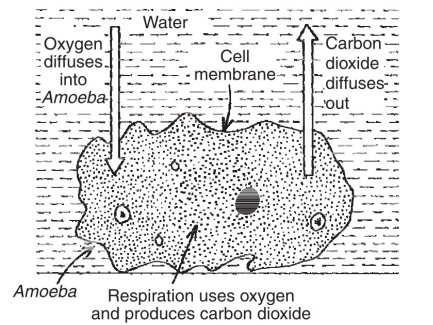
- Since the Amoeba is very small in size, so the oxygen spreads quickly into the whole body of Amoeba. This oxygen is used for respiration(energy release) inside the Amoeba cell. The process of respiration produces carbon dioxide gas continuously. This carbon dioxide gas diffuses out through the membrane of Amoeba into the surrounding water.
- Thus, the breathing surface (or respiratory surface) of Amoeba is its cell surface membrane. In addition to Amoeba, other simple animals like Paramecium and Planaria also depend on the simple diffusion of gases for breathing and respiration.Thus, Amoeba, Paramecium and Planaria all breathe through their cell membranes.
- In the small, single-celled animals such as Amoeba, the volume of their body is so small that oxygen can be introduced quickly into the whole body by the process of diffusion.This is because due to the smallness of Amoeba cell, the oxygen does not have to go far. But this is not so in larger animals like earthworms, grasshopper, fish and man (humans), etc.
- In large animals, the volume of body is so big that oxygen cannot diffuse into all the cells of the body quickly. This is because in these cases the oxygen has to travel a very large distance to reach each and every cell of the body. So, in large animals, there is a blood circulatory system to carry oxygen to all the parts of the body quickly (and remove carbon dioxide).
- The blood contains respiratory pigments which take up oxygen from air and carry it to the body cells. This will become more clear from the following example.
Diffusion is insufficient to meet the oxygen requirements of large multicellular organisms like humans because the volume of human body is so big that oxygen cannot diffuse into all the cells of the human body quickly.
- This is because oxygen will have to travel large distances inside the human body to reach each and every cell of the body. Diffusion being a very slow process will take a lot of time to make oxygen available to all the body cells.
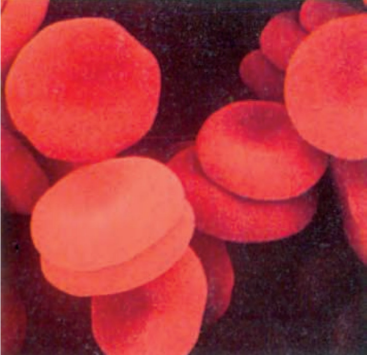
- For example, it has been estimated that if diffusion were to provide oxygen in our body, then it would take about 3 years for a molecule of oxygen from our lungs to reach our toes by the process of diffusion. On the other hand, the blood circulatory system in humans carries oxygen to all the parts of the body quickly (and removes carbon dioxide).
- Actually, human blood contains a respiratory pigment called haemoglobin which carries the oxygen from the lungs to all the body cells very efficiently. Haemoglobin is present in red blood corpuscles. We will now discuss the process of breathing and respiration in some large animals like earthworm, fish and humans.
“Karnataka SSLC Class 10 Biology Chapter 1 notes”
KSEEB Class 10 SSLC Biology Respiration In Earthworm
- The earthworm exchanges the gases through its skin (see Figure 56). This means that the respiratory surface of an earthworm is its skin. The skin of an earthworm is quite thin and moist, and has a good blood supply.
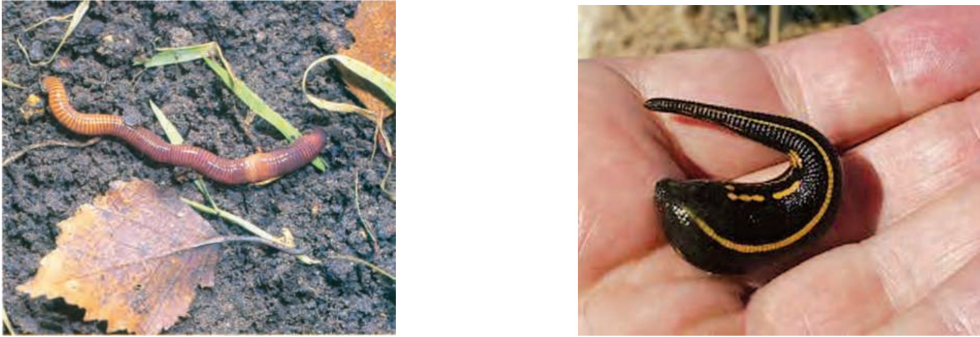
- So, the earthworm absorbs the oxygen needed for respiration through its moist skin. This oxygen is then transported to all the cells of the earthworm by its blood where it is used in respiration. The carbon dioxide produced during respiration is carried back by the blood.
- This carbon dioxide is expelled from the body of the earthworm through its skin. Thus, in earthworm, gaseous exchange takes place through the skin which is thin and moist. Just like earthworms, the leeches also absorb the oxygen needed for respiration through their skin. And carbon dioxide produced inside the leeches (during respiration) also goes out through the skin.
KSEEB Class 10 SSLC Biology Respiration In Fish
- The fish has special organs of breathing called ‘gills’. The fish has gills on both the sides of its head. The gills are covered by gill covers so they are not visible from outside. The fish lives in water and this water contains dissolved oxygen in it. For breathing, the fish uses the oxygen which is dissolved in water. This happens as follows.

- The fish breathes by taking in water through its mouth and sending it over the gills. When water passes over the gills, the gills extract dissolved oxygen from this water. The water then goes out through the gill slits (hidden under the gill cover). Thus, the dissolved oxygen is extracted from water by the fish when it flows over the gills.
- The extracted oxygen is absorbed by the blood and carried to all the parts of the fish. The carbon dioxide produced by respiration is brought back by the blood into the gills for expelling into the surrounding water. The fish has no lungs like us, the gaseous exchange in fish takes place in the gills. So, the respiratory surface of a fish is the surface of its gills.
- It is a common observation that when a fish is taken out from water it dies soon (even though there is a lot of oxygen in the air around it). This is because a fish does not have lungs to utilise the oxygen of air for breathing and respiration. The fish has gills which can extract only dissolved oxygen from water and provide it to fish.
- Gills cannot take in the oxygen from air on land. Since fish does not get oxygen for breathing when taken out of water, it dies. In addition to fish, many other aquatic animals like prawns and mussels also have special organs called ‘gills’ for breathing and respiration.
- Please note that the fish and earthworm do not exchange the gases during respiration in the same way. The fish exchanges the gases by using its special organs called ‘gills’ whereas the earthworm exchanges the gases through its thin and moist ‘skin’.
KSEEB Class 10 SSLC Biology Respiration In Humans
- Like other land animals, human beings are air breathers. Air contains oxygen. The human beings need oxygen to stay alive. We get this oxygen by breathing in air. The oxygen helps to break down the food absorbed in the body to release energy.
- This energy is used for maintaining our life. The process by which energy is released from food in our body is called respiration. Carbon dioxide and water are the two by- products of respiration. The process of respiration takes place inside the cells of our body. It involves our respiratory system.
- The function of respiratory system is to breathe in oxygen for respiration (producing energy from food), and to breathe out carbon dioxide produced by respiration. The breathing organs of human beings are lungs . It is in the lungs that the gases are exchanged between the blood and air.
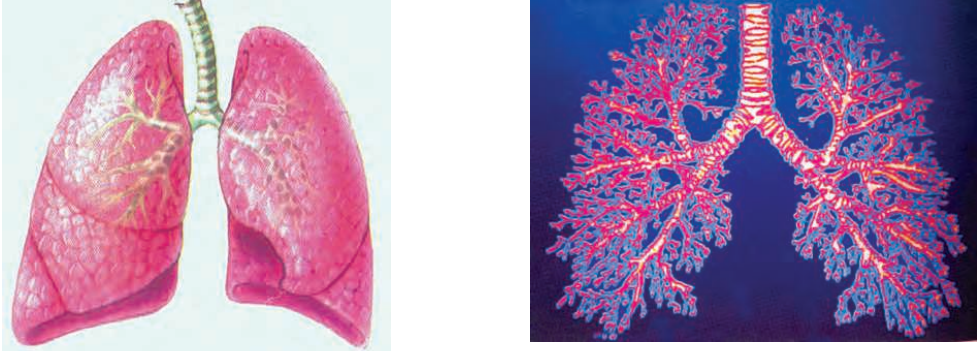
- The gases exchanged between blood and air are oxygen and carbon dioxide. We will now describe the human respiratory system in detail. Before we go further and describe the human respiratory system in detail, it is necessary to learn the process of breathing which is an important part of respiration. This is discussed below.
- We can live without food and water for many days but we cannot live for more than a few minutes without air. This is because air is necessary for breathing. During breathing, we take air into our lungs through the nose, and then expel it. The ordinary air which we take into the lungs is rich in oxygen but the air expelled from the lungs is rich in carbon dioxide.
- We can now define breathing as follows : Breathing is the process by which air rich in oxygen is taken inside the body of an organism and air rich in carbon dioxide is expelled from the body (with the help of breathing organs). The breathing in human beings takes place through the organs called lungs.
- The taking in of air rich in oxygen into the body during breathing is called ‘inhalation’ and giving out (or expelling) the air rich in carbon dioxide is called ‘exhalation’. Both, inhalation and exhalation take placeregularly during breathing. A breath means ‘one inhalation plus one exhalation’. We know that air contains
- oxygen. So, when we breathe in air, it is actually the oxygen gas present in air which is utilised by our body (to break down food and produce energy). Thus, we ‘breathe in’ air to supply oxygen to the cells of our body (for the breakdown of food to release energy), and we ‘breathe out’ to remove waste product carbon dioxide from our body
- (which is produced during the breakdown of food in the cells). Breathing is a continuous process which goes on all the time throughout our life.
We will now learn the mechanism of breathing.
- That is , we will now learn how air from outside is sucked into our lungs during inhaling (breathing in), and how air from our lungs is pushed out during exhaling (breathing out). The process of breathing takes place in our lungs. Lungs are connected to our nostrils (holes in the nose) through nasal passage (or nasal cavity) and windpipe.
- When we inhale air, it enters our nostrils , passes through nasal passage and windpipe, and reaches our lungs. Our two lungs hang in an airtight space in our body called ‘chest cavity’. Around the sides of the chest cavity is the rib cage with sheets of muscles between the ribs. The rib cage encloses the lungs in it .
- At the bottom of the chest cavity is a curved sheet of muscle called diaphragm .Diaphragmforms the floor of chest cavity. Breathing involves the movements of the rib cage and the diaphragm. This happens as follows :
Breathing in. When we breathe in (or inhale), then two things happen at the same time :
- the muscles between the ribs contract causing the rib cage to move upward and outward, and
- the diaphragm contracts and moves downward [see Figure 63(a)]. The upward and outward movement of rib cage, as well as the downward movement of diaphragm, both increase the space in the chest cavity and make it larger. As the chest cavity becomes larger, air is sucked in from outside into the lungs. The lungs get filled up with air and expand.

- Breathing in : chest cavity becomes (b) Breathing out : chest cavity becomes bigger, air is sucked into lungs smaller, air is pushed out of lungs . The mechanism of breathing.
- Breathing out. When we breathe out (or exhale), even then two things happen at the same time :
- the muscles between the ribs relax causing the rib cage to move downward and inward, and
- thediaphragm relaxes and moves upward. The downward and inward movement of rib cage,as well as the upward movement of diaphragm, both decrease the space in our chest cavity and make it smaller. As the chest cavity becomes smaller, air is pushed out from the lungs.
“Comprehensive Life Processes notes for SSLC”
KSEEB Class 10 SSLC Biology Respiratory System in Humans
- In human beings, many organs take part in the process of respiration. We call them organs of respiratory system. The main organs of human respiratory system are : Nose, Nasal passage (or Nasal cavity), Trachea, Bronchi, Lungs and Diaphragm. The human respiratory system.
- The human respiratory system begins from the nose. Our nose has two holes in it which are called nostrils. There is a passage in the nose behind the nostrils which is called nasal passage (or nasal cavity). The air for respiration is drawn into our body through the nostrils present in the nose.
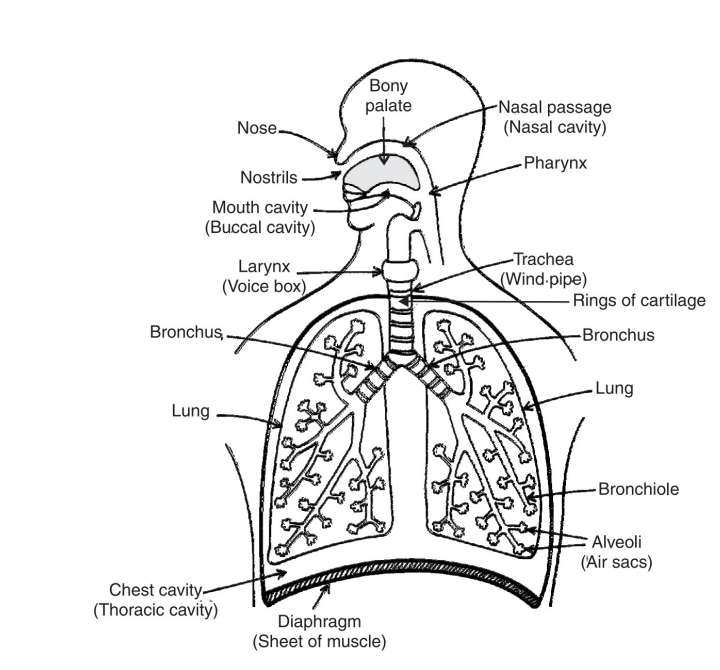
- This air then goes into nasal passage. The nasal passage is separated from the mouth cavity (buccal cavity or oral cavity) by a hard, bony palate so that we can breathe in air even when we are eating food (and the mouth cavity is filled with food). The nasal passage is lined with fine hair and mucus (Mucus is secreted by the glands inside the nasal passage).
- When air passes through the nasal passage, the dust particles and other impurities present in it are trapped by nasal hair and mucus so that clean air goes into the lungs. The part of throat between the mouth and wind pipe is called pharynx. From the nasal passage, air enters into pharynx and then goes into the wind pipe (or trachea) .
- The trachea is a tube which is commonly known as wind pipe. The air coming from the nostrils during breathing passes through trachea. Trachea does not collapse even when there is no air in it because it is supported by rings of soft bones called cartilage. The upper end of trachea has a voice box called larynx.
- The trachea runs down the neck and divides into two smaller tubes called ‘bronchi’ at its lower end. (The singular of bronchi is bronchus). The two bronchi are connected to the two lungs. The lungs lie in the chest cavity or thoracic cavity which is separated from abdominal cavity by a muscular partition called diaphragm.
- The lungs are covered by two thin membranes called pleura. The lungs are enclosed in a ‘rib cage’ made of bones called ‘ribs’. We have not shown the rib cage to keep the diagram simple. Each bronchus divides in the lungs to form a large number of still smaller tubes called ‘bronchioles’.
- The smallest bronchioles have tiny air-sacs at their ends. The pouch-like air-sacs at the ends of the smallest bronchioles are called ‘alveoli’ (singular alveolus). The walls of alveoli are very thin and they are surrounded by very thin blood capillaries. It is in the alveoli that oxygen is taken into the body and carbon dioxide is eliminated. In other words, it is in the alveoli that gaseous exchange takes place.
- The human lungs have been designed to maximise the exchange of gases as follows : There are millions of alveoli in the lungs. The presence of millions of alveoli in the lungs provides a very large area for the exchange of gases. And the availability of large surface area maximises the exchange of gases.
- For example, if all alveoli from the two human lungs are unfolded, they would give an area of about 80 square metres (which is nearly the size of a tennis court !). The diaphragm is a sheet of muscle below the lungs. It helps in ‘breathing in’ and ‘breathing out’. The muscles of chest also help in breathing in and breathing out.
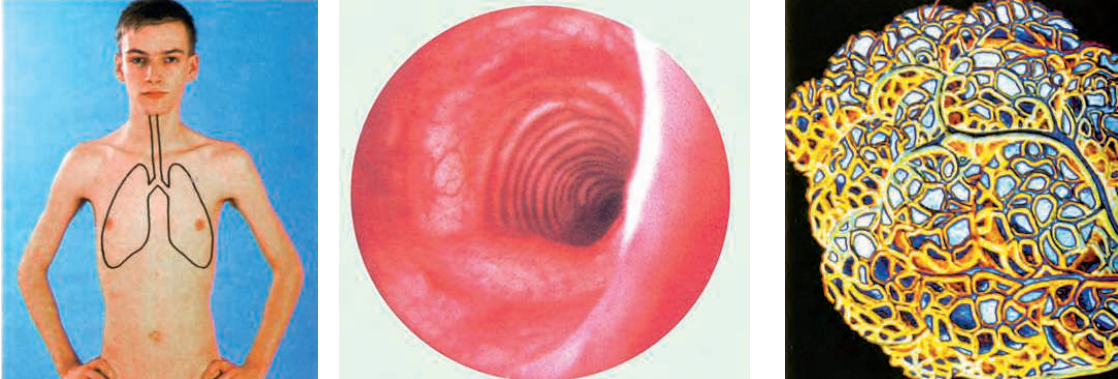
- When we breathe in air, the diaphragm and muscles attached to the ribs contract due to which our chest cavity expands. This expansion movement of the chest increases the volume inside the chest cavity.
- Due to increase in volume, the air pressure decreases inside the chest cavity and air from outside (being at higher pressure) rushes into the lungs through the nostrils, trachea and bronchi. In this way, during the process of ‘breathing in’ the air sacs or alveoli of the lungs get filled with air containing oxygen.
- The alveoli are surrounded by very thin blood vessels called capillaries carrying blood in them. So, the oxygen of air diffuses out from the alveoli walls into the blood. The oxygen is carried by blood to all the parts of the body (This oxygen is carried by a red pigment called haemoglobin present in blood).
- As the blood passes through the tissues of the body, the oxygen present in it diffuses into the cells (due to its higher concentration in the blood). This oxygen combines with the digested food (glucose) present in the cells to release energy. Carbon dioxide gas is produced as a waste product during respiration in the cells of the body tissues. This carbon dioxide diffuses into the blood (due to its higher concentration in body tissues).
- Blood carries the carbon dioxide back to the lungs where it diffuses into the alveoli. When we breathe out air, the diaphragm and the muscles attached to the ribs relax due to which our chest cavity contracts and becomes smaller. This contraction movement of the chest pushes out carbon dioxide from the alveoli of the lungs into the trachea, nostrils and then out of the body into air.
- In this way the process of gaseous exchange is completed in the human respiratory system. Please note that during the breathing cycle, when air is taken in (or inhaled) and let out (or exhaled), the lungs always contain a certain residual volume of air so that there is sufficient time ‘for the oxygen to be absorbed’ into the blood and ‘for the carbon dioxide to be released’ from the blood. Another point to be noted is that carbon dioxide is more soluble in water (than oxygen), so it is mostly transported in the dissolved form in our blood.
Experiment to Show That Carbon Dioxide is Produced During Respiration
- We know that carbon dioxide gas turns lime-water milky. The fact that carbon dioxide is produced during respiration can be shown by demonstrating the effect of inhaled air and exhaled air on lime-water.
- The apparatus to demonstrate the effect of inhaled air and exhaled air on lime-water.
- The apparatus consists of two boiling tubes A and B fitted with two-holed corks. The boiling tubes A and B are connected through a special type of glass tube C. The left arm of glass tube C is short which goes in the boiling tube A. The right arm of glass tube C is long and dips in lime-water in boiling tube B.The boiling tube A has another bent glass tube D whose longer side dips in lime-water contained in it.
- The boiling tube B has also another short, bent tube E in it which does not dip in lime-water. To perform the experiment, we put the top end of the tube C in mouth and ‘breathe in’ and ‘breathe out’ gently. When we breathe in, then the inhaled air (fresh air) enters the glass tube D and passes through the lime-water in boiling tube A. And when we breathe out, then the exhaled air (coming from our lungs) passes through the lime-water in boiling tube B.
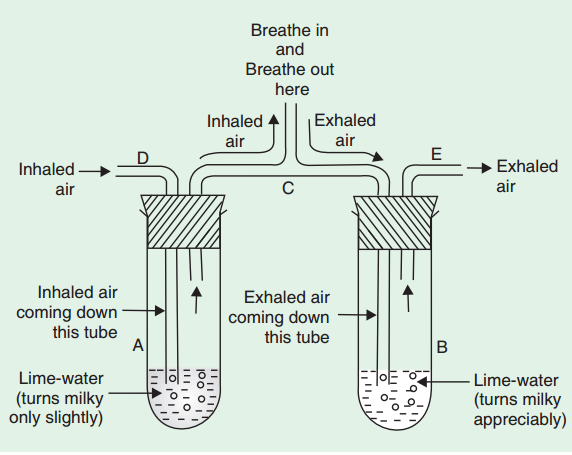
- We continue to breathe in and breathe out for about five minutes. We will find that the lime- water in boiling tube A (in which inhaled air is passed) turns milky only slightly but the lime-water in boiling tube B (in which exhaled air is passed) turns milky appreciably. This shows that less carbon dioxide is present in inhaled air but much more carbon dioxide is present in exhaled air.
- From this observation we conclude that carbon dioxide is produced during respiration (which comes out in exhaled air). The air which we ‘inhale’ is a mixture of gases and the air which we ‘exhale’ is also a mixture of gases.
- The only difference in the inhaled air and exhaled air is that they contain different proportions of oxygen, carbon dioxide and water vapour. (The proportion of nitrogen gas in the inhaled air and exhaled air remains the same, 78 per cent, because it is neither used up in respiration nor produced during respiration). The proportions of oxygen, carbon dioxide and water vapour in ‘inhaled air’ and ‘exhaled air’ are given below :

- We can see from the above figures that the air which we inhale contains a greater proportion (21 per cent) of oxygen. Now, some of the oxygen of inhaled air is used up in breaking down glucose food during respiration, so the exhaled air which comes out after the process of respiration contains a lower proportion (16.4 per cent) of oxygen.
- The air which we inhale contains a lower proportion (0.04 per cent) of carbon dioxide. Now, during respiration, when oxygen breaks down glucose food, then a lot of carbon dioxide is produced, so the exhaled air which comes out after respiration contains a much higher proportion (4.4 per cent) of carbon dioxide.
- Again, the air which we inhale contains only a little of water vapour. Now, when glucose food is broken down by oxygen during respiration, then water is also produced (alongwith carbon dioxide). So, the exhaled air contains a lot more water vapour than inhaled air.
KSEEB Class 10 SSLC Biology Rate of Breathing
- The process of breathing pumps in oxygen into our body (and removes carbon dioxide). Breathing occurs involuntarily (on its own) but the rate of breathing is controlled by the respiratory system of brain.
- The average breathing rate in an adult man at rest is about 15 to 18 times per minute. This breathing rate increases with increased physical activity. For example, if we do some physical exercise (like sit-up exercise), then our breathing rate goes up considerably. This is because when we do some physical exercise, then our body needs more energy.
- And to produce more energy through respiration, our body requires more oxygen gas. Rapid breathing supplies more oxygen to body cells for producing more energy required for doing physical exercise. Thus, we breathe faster after exercise so as to produce more energy to compensate the loss of energy suffered by our body in doing exercise.
SSLC Class 10 Life Processes chapter key points”
- We all breathe through nose. We can, however, not breathe inside water when we are diving. This is because water does not have free air or oxygen for us to breathe (and we do not have gills like the fish to utilise oxygen dissolved in water). So, the deep sea divers carry oxygen gas cylinders with them for breathing when they go under the sea.
- We have just studied that oxygen required for breathing and respiration (release of energy) is carried by haemoglobin present in our blood. The normal range of haemoglobin in the blood of a healthy adult person is from 12 to 18 grams per decilitre (12 to 18 g/dL) of blood. The deficiency of haemoglobin in the blood of a person reduces the oxygen-carrying capacity of blood resulting in breathing problems, tiredness and lack of energy.
- The person looks pale and loses weight. Many times we have heard of carbon monoxide poisoning. This happens as follows. Carbon monoxide gas (CO) is formed whenever a fuel burns in an insufficient supply of air. For example, if coal (or charcoal) is burned in a closed space (like a room with closed doors and windows), then a lot of carbon monoxide is formed.
- Carbon monoxide is also produced when petrol burns in a car engine. Now, we know that haemoglobin present in our blood carries oxygen to all the parts of our body.

- Haemoglobin has more affinity (or attraction) for carbon monoxide than oxygen, So, if carbon monoxide gas is inhaled by a person, then this carbon monoxide binds very strongly with haemoglobin in the blood and prevents it from carrying oxygen to the brain and other parts of the body.
- Due to lack of oxygen, the person cannot breathe properly. If carbon monoxide is inhaled for a long time, then the person becomes unconscious and can even die due to oxygen starvation.
- The persons having breathing problems (or respiratory problems) are given oxygen masks to facilitate breathing. In serious cases, the patient is put on a machine called ‘ventilator’ in which a tube is inserted directly into the trachea (or wind pipe) of the patient to help him in breathing comfortably. Before we go further and describe the transport of materials in plants and animals.
KSEEB SSLC Class 10 Social Science Notes History
- Chapter 1 Advent of Europeans to India Notes
- Chapter 2 The Extension of the British Rule Notes
- Chapter 3 The Impact of British Rule in India Notes
- Chapter 4 Opposition to British Rule in Karnataka Notes
- Chapter 5 Social and Religious Reformation Movements Notes
- Chapter 6 The First War of Indian Independence (1857) Notes
- Chapter 7 Freedom Movement Notes
- Chapter 8 Era of Gandhi and National Movement Notes
- Chapter 9 Post Independent India Notes
- Chapter 10 The Political Developments of 20th Century Notes
KSEEB SSLC Class 10 Social Science Notes Political Science
- Chapter 1 The Problems of India and their Notes
- Chapter 2 Indian Foreign Policy Notes
- Chapter 3 India’s Relationship with Other Countries Notes
- Chapter 4 Global Problems and India’s Role Notes
- Chapter 5 International Institutions Notes
KSEEB SSLC Class 10 Social Science Notes Sociology
- Chapter 1 Social Stratification Notes
- Chapter 2 Labour Notes
- Chapter 3 Social Movements Notes
- Chapter 4 Social Problems Notes
KSEEB SSLC Class 10 Social Science Notes Geography
- Chapter 1 Indian Position and Extension Notes
- Chapter 2 Indian Physiography Notes
- Chapter 3 Indian Climate Notes
- Chapter 4 Indian Soils Notes
- Chapter 5 Indian Forest Resources Notes
- Chapter 6 Indian Water Resources Notes
- Chapter 7 Indian Land Resources Notes
- Chapter 8 Indian Mineral & Power Resources Notes
- Chapter 9 Indian Transport and Communication Notes
- Chapter 10 Indian Industries Notes
- Chapter 11 Indian Natural Disasters Notes
- Chapter 12 Indian Population Notes
KSEEB SSLC Class 10 Social Science Notes Economics
- Chapter 1 Development Notes
- Chapter 2 Rural Development Notes
- Chapter 3 Money and Credit Notes
- Chapter 4 Public Finance and Budget Notes
